Class 10 Science Chapter 11 Human Eye and Colourful World NCERT Solutions
Before getting into the details of NCERT Solutions For Class 10 Science Chapter 11 Human Eye And Colourful World, let’s have an overview of list of topics and subtopics under class 10 science chapter 11 NCERT solutions:
- The Human Eye And The Colourful World
- The Human Eye
- Defects Of Vision And Their Correction
- Refraction Of Light Through A Prism
- Dispersion Of White Light By A Glass Prism
- Atmospheric Refraction
- Scattering Of Light
Free download NCERT Solutions for Class 10 Science Chapter 11 Human Eye And Colourful World PDF in Hindi Medium as well as in English Medium for CBSE, Uttarakhand, Bihar, MP Board, Gujarat Board, and UP Board students, who are using NCERT Books based on updated CBSE Syllabus for the session 2019-20.
- मानव-नेत्र एवं रंगबिरंगी दुनियाँ कक्षा 10 विज्ञान हिंदी में
- Class 10 Human Eye and Colourful World Important Questions
- Human Eye and Colourful World Class 10 Notes
- Human Eye and Colourful World NCERT Exemplar Solutions
- Human Eye and Colourful World Class 10 Extra Questions
- Class 10 Science Human Eye and Colorful World Mind Map
NCERT Solutions for Class 10 Science Chapter 11 Intext Questions
Page Number: 190
Question 1
What is meant by power of accommodation of the eye ?
Answer:
The power of accommodation of the eye is the maximum variation of its power for focusing on near and far (distant) objects.
Question 2
A person with a myopic eye cannot see objects beyond 1.2 m distinctly. What should be the type of the corrective lens used to restore proper vision ?
Answer:
Concave lens.
Question 3
What is the far point and near point of the human eye with normal vision ?
Answer:
For a human eye with normal vision the far point is at infinity and near point is 25 cm from the eye.
Question 4
A student has difficulty reading the blackboard while sitting in the last row. What could be the defect the child is suffering from ? How can it be corrected?
Answer:
The child is suffering from myopia. The child should use concave lens of suitable focal length.
NCERT Solutions for Class 10 Science Chapter 11 Textbook Chapter End Questions
Question 1
The human eye can focus objects at different distances by adjusting the focal length of the eye lens. This is due to
(a) presbyopia
(b) accommodation
(c) near – sightedness
(d) far – sightedness
Answer:
(b) Accommodation
Question 2
The human eye forms the image of an object at its
(a) cornea
(b) iris
(c) pupil
(d) retina
Answer:
(d) Retina
Question 3
The least distance of distinct vision for a young adult with normal vision is about
(a) 25 m
(b) 2.5 cm
(c) 25 cm
(d) 2.5 m
Answer:
(c) 25 cm
Question 4
The change in focal length of an eye lens is caused by the action of the
(a) pupil
(b) retina
(c) ciliary muscles
(d) iris
Answer:
(c) Ciliary muscles
Question 5
A person needs a lens of power -5.5 dioptres for correcting his distant vision. For correcting his near vision he needs a lens of power +1.5 dioptre. What is the focal length of the lens required for correcting (i) distant vision, and (ii) near vision ?
Solution:
(i) ∵ Power of distant viewing part of the lens, P1 = -5.5 D
∴ Focal length of this part, f1 =
(ii) For near vision,![]()
Question 6
The far point of a myopic person is 80 cm in front of the eye. What is the nature and power of the lens required to correct the problem ?
Solution:
The remedial lens should make the objects at infinity appear at the far point.
Therefore, for object at infinity, u = ∞
Far point distance of the defected eye, ν = – 80 cm
Negative sign shows that the remedial lens is a concave lens.
Question 7
Make a diagram to show how hypermetropia is corrected. The near point of a hypermetropic eye is 1 m. What is the power of the lens required to correct the defect ? Assume that the near point of the normal eye is 25 cm.
Solution:
(i) The near point N of hypermetropic eye is farther away from the normal near point N.
(ii) In a hypermetropic eye, the image of nearby object lying at normal near point N (at 25 cm) is formed behind the retina.
(iii) Correction of hypermetropia : The convex lens forms a virtual image of the object (lying at normal near point N) at the near point N’ of this eye.
The object placed at 25 cm from the correcting lens must produce a virtual image at 1 m or 100 cm.
Therefore, u = – 25 cm, ν = 100 cm
The positive sign shows that it is a convex lens.
Question 8
Why is a normal eye not able to see clearly the objects placed closer than 25 cm ?
Answer:
At distance less than 25 cm, the ciliary muscles cannot bulge the eye lens any more, the object cannot be focused on the retina and it appears blurred to the eye, as shown in the given figure.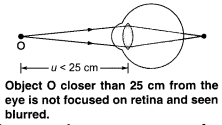
Question 9
What happens to the image distance in the eye when we increase the distance of an object from the eye ?
Answer:
The eye lens of a normal eye forms the images of objects at various distances on the same retina. Therefore, the image distance in the eye remains the same.
Question 10
Why do stars twinkle ?
Answer:
Stars appear to twinkle due to atmospheric refraction. The light of star after the entry of light in earth’s atmosphere undergoes refraction continuously till it reaches the surface of the earth. Stars are far away. So, they are the point source of light. As the path of light coming from stars keep changing, thus the apparent position of stars keep changing and amount of light from stars entering the eye keeps twinkling. Due to which a star sometimes appear bright and sometimes dim, which is the effect of twinkling.
Question 11
Explain why the planets do not twinkle ?
Answer:
The planets are much nearer to the earth than stars and because of this they can be considered as large source of light. If a planet is considered to be a collection of a very large number of point sources of light, then the average value of change in the amount of light entering the eye from all point size light sources is zero. Due to this the effect of twinkling is nullified.
Question 12
Why does the sun appear reddish early in the morning ?
Answer:
The light coming from the sun passes through various denser layers of air in the earth’s atmosphere before reaching our eyes near the horizon. Most of the part of blue light and light of small wavelength gets scattered by dust particles near the horizon. So, the light reaching our eyes is of large wavelength. Due to this the sun appears reddish at the time of sunrise and sunset.
Question 13
Why does the sky appear dark instead of blue to an astronaut ?
Answer:
As an astronaut moves away from the atmosphere of earth, the atmosphere becomes thin. Due to the absence of molecules (or dust particles) in air, the scattering of light does not take place. Thus, sky appears dark in the absence of scattering.
NCERT Solutions for Class 10 Science Chapter 11 Human Eye and Colourful World
Functioning of a lens in human eye, defects of vision and their corrections, applications of spherical mirrors and lenses. Refraction of light through a prism, dispersion of light, scattering of light, applications in daily life.
| Board | CBSE |
| Textbook | NCERT |
| Class | Class 10 |
| Subject | Science |
| Chapter | Chapter 11 |
| Chapter Name | Human Eye and Colourful World |
| Number of Questions Solved | 17 |
| Category | NCERT Solutions |
Page 190
Question 1.
What is meant by power of accommodation of the eye?
Answer:
The power Of accommodation of the eye is the ability of the eye to observe the distinct objects clearly which are situated at a large distance from the eye. The ciliary muscles are responsible to change the focal length Of the eye lens. The value of the power of accommodation Of the normal human eye is (d = 25 cm) = 100/f = 100/d = 100/25 = 4 dioptres. The value of power of accommodation Of human eye is about 4D
Question 2.
A person with a myopic eye cannot see objects beyond 1.2 m distinctly. What should be the type of the corrective lens used to restore proper vision?
Answer:
The far point for myopic eye is 1.2m.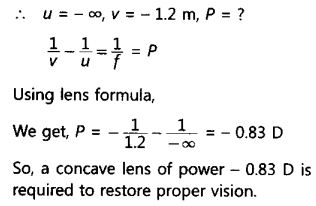
Question 3.
What is the far point and near point of the human eye with normal vision ?
Answer:
For human eye with normal vision, far point is at infinity and near point is at 25 cm from the eye.
Question 4.
A student has difficulty reading the blackboard while sitting in the last row. What could be the defect the child is suffering from ? How can it be corrected ?
Answer:
As the child has difficulty in reading the blackboard, he is suffering from myopia or short sightedness. To correct this defect, he has to use spectacles with concave lens of suitable focal length.
Page 197 – 198
Question 1.
The human eye can focus objects at different distances by adjusting the focal length of the eye lens. This is due to
(a) presbyopia
(b) accommodation
(c) near-sightedness
(d) far-sightedness
Answer:
(b) Human eye can change the focal length of the eye lens to see the objects situated at various distances from the eye. This is possible due to the power of accommodation of the eye lens.
Question 2.
The human eye forms the image of an object at its
(a) cornea (b) iris (c) pupil (d) retina
Answer:
(d) The human eye forms the image of an object at its retina.
Question 3.
The least distance of distinct vision for a young adult with normal vision is about
(a) 25 m
(b) 2.5 cm
(c) 25 cm
(d) 2.5 m
Answer:
(c) The least distance of distinct vision is the minimum distance of an object to see clear and distinct image. It is 25 cm for a young adult with normal visions.
Question 4.
The change in focal length of an eye lens is caused by the action of the
(a) pupil
(b) retina
(c) ciliary muscles
(d) iris
Answer:
(c) The relaxation or contraction of ciliary muscles changes the curvature of the eye lens. The change in curvature of the eye lens changes the focal length of the eyes. Hence, the change in focal length of an eye lens is caused by the action of ciliary muscles.
Question 5.
A person needs a lens of power – 5.5 dioptres for correcting his distant vision. For correcting his near vision he needs a lens of power +1.5 dioptre. What is the focal length of the lens required for correcting (i) distant vision, and (ii) near vision?
Answer: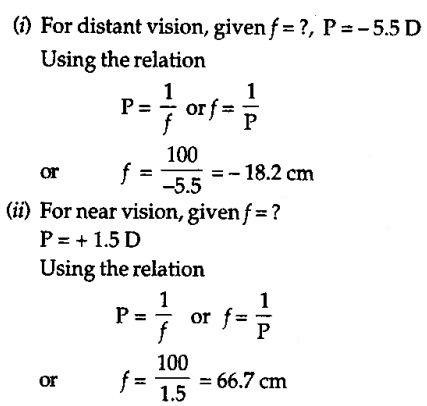
Question 6.
The far point of a myopic person is 80 cm in front of the eye. What is the nature and power of the lens required to correct the problem?
Answer: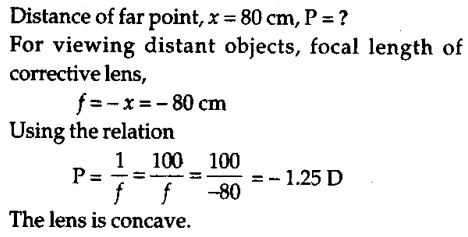
Question 7.
Make a diagram to show how hypermetropia is corrected. The near point of a hypermetropic eye ¡s 1 m. What ¡s the power of a lens required to correct this defect? Assume that near point of the normal eye is 25 cm.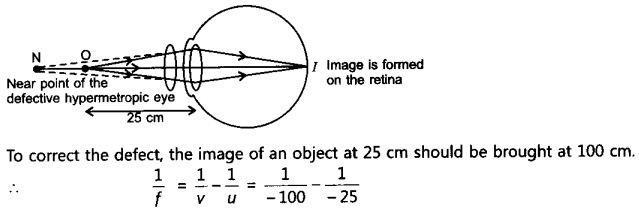
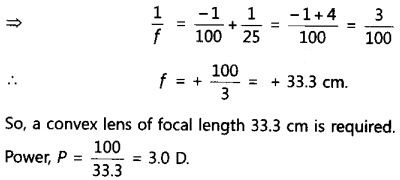
Question 10.
Why do stars twinkle?
Answer: The stars twinkle at night, because the star light reaching Our eyes increases and decreases continuously due to atmospheric refraction. When star light reaching our eyes increases, the star looks bright and when the star light reaching our eyes decreases, it appears dim.
Question 11.
Explain why the planets do not twinkle ?
Answer:
Planets being close to earth appear larger in size. A planet can be Considered as a collection of large number of small sized objects. Twinkling effect Of these objects cancel each other. so, planets do not appear to twinkle.
Question 12.
Why does the sun appear reddish early in the morning?
Answer: At sunrise, the sun looks almost reddish because only red colour which is least scattered is received by our eye and appears to come from sun. Hence the appearance Of sun at sunrise, near the horizon looks almost reddish.
Question 13.
Why does the sky appear dark of blue to an astronaut?
Answer:
At such huge heights due to absence of atmosphere, no scattering of the light takes place. Therefore sky appears dark.
Multiple Choice Questions (MCQs) [1 Mark each]
Question 1.
The human eye forms the image of an object at its [NCERT]
(a) cornea
(b) iris
(c) pupil
(d) retina
Answer:
(d) Retina is the light sensitive surface of eye on which the image is formed.
Question 2.
The human eye can focus objects at different distances by adjusting the focal length of eye lens. This is due to [NCERT]
(a) presbyopia
(b) accommodation
(c) nearsightedness
(d) farsightednes
Answer:
(b) Accommodation is the ability of eye lens to focus both near and distant objects by adjusting its focal length.
Question 3.
The change in focal length of eye lens is caused by action of [NCERT]
(a) pupil
(b) retina
(c) ciliary muscles
(d) iris
Answer:
(c) Ciliary muscles contract and extend in order to change the lens shape for focussing image ayretina.
Question 4.
The least distance of distinct vision for a young adult with normal vision is about [NCERT]
(a) 25 m
(b) 2.5 cm
(c) 25 cm
(d) 2.5 m
Answer:
(c) The minimum distance at which an object can be seen most distinctly without any strain is 25 cm.
Question 5.
At noon the Sun appears white as [NCERT Exemplar]
(a) light is least scattered
(b) all the colours of the white light are scattered away
(c) blue colour is scattered the most
(d) red colour is scattered the most
Answer:
(a) At noon, the Sun appears white because the light from the Sun is directly over head and travel relatively shorter distance. The Sun appears white as only a little of the blue and violet colours are scattered.
Question 6.
A person cannot see distinctly objects kept beyond 2 m. This defect can be corrected by using a lens of power [NCERT Exemplar]
(a) +0.5 D
(b) -0.5 D
(c) +0.2 D
(d) -0.2 D
If a person cannot see distinctly, objects kept beyond 21 m, then he is suffering from myopia.
Answer:
(b) As the person has the eye defect, myopia, therefore a concave lens has to be used whose focal length will be f = -2 m (using sign convention). Thus,
Power, P = 1/f [where, f is focal length in metre.]
= 1/-2 = -0.5D .
Question 7.
Which of the following phenomena of light are involved in the formation of a rainbow? [NCERT Exemplar]
(a) Reflection, refraction and dispersion
(b) Refraction, dispersion and total internal reflection
(c) Refraction, dispersion and internal reflection
(d) Dispersion, scattering and total internal reflection
Answer:
(c) A rainbow is caused by dispersion, refraction and internal reflection of sunlight by tiny water droplets, present in the atmosphere and always formed in a direction opposite to that of the Sun. The water droplets act like small prisms. They refract and disperse the incident sunlight, then reflect it internally and finally refract it again when it comes out of the raindrop.
Question 8.
A prism ABC (with BC as base) is placed in different orientations. A narrow beam of white light is incident on the prism as shown in figure. In which of the following cases, after dispersion, the third colour from the top corresponds to the colour of the sky? [NCERT Exemplar]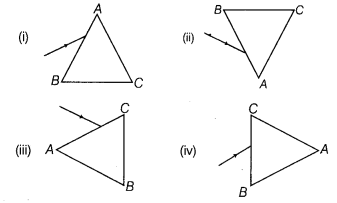
(a) Only (i)
(b) Only (ii)
(c) Only (iii)
(d) Only (iv)
Answer:
(b) In (ii) case, after dispersion, the third colour from the top corresponds to colour of the sky, i.e. blue.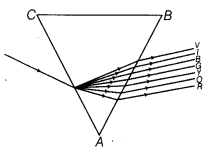
Question 9.
A student sitting on the last bench can read the letters written on the blackboard but is not able to read the letters written in his text book. Which of the following statements is correct?
(a) The near point of his eyes has receded away
(b) The near point of his eyes has come closer to him
(c) The far point of his eyes has come closer to him
(d) The far point of his eyes has receded away
Hypermetropia may have blurred vision to a person when looking at an object close to them and clearer 1 vision while looking at an object at the distance.
Answer:
(a) The student sitting on the last bench can read the letters written on the blackboard but is not able to read the letters written in his text book because he is suffering from hypermetropia or far sightedness. He can see distant objects clearly but cannot see nearby objects distinctly.
Question 10.
In the following diagram, the path of a ray of light passing through a glass prism is shown below.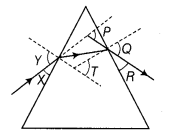
In this diagram, the angle of incidence, the angle of emergence and the angle of deviation respectively, are [CBSE2014]
(a) X, R and T
(b) Y, Q and T
(c) X, Q and P
(d) Y, Q and P
Answer:
(d) Angle of incidence is the angle made by the incident ray with the normal to the first surface of prism, which is shown by angle Y. Angle of emergence is the angle made by the emergent ray with the normal to the surface when it comes out from the prism after refraction, which is shown by angle Q. Angle of deviation is the angle between the incident ray and the emergent ray, which is shown by angle P.
NCERT Solutions for Class 10 Science Chapter 11 Human Eye and Colourful World (Hindi Medium)
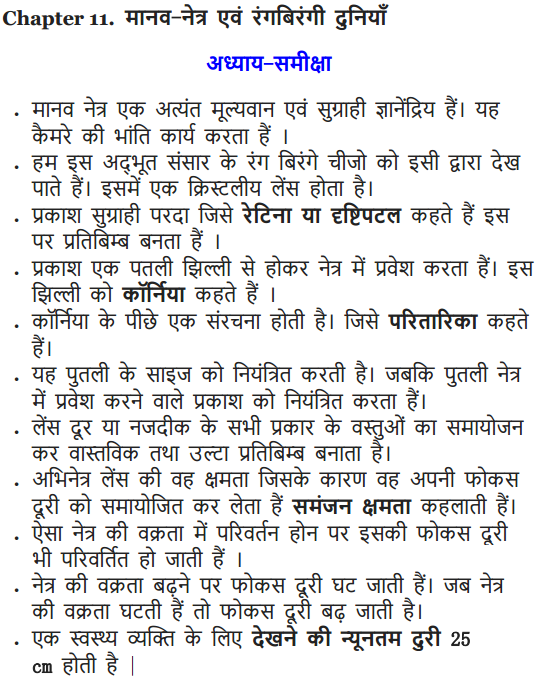

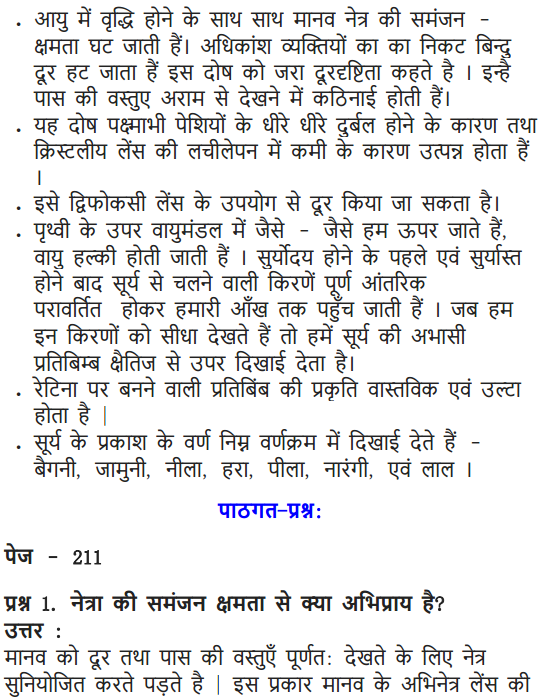
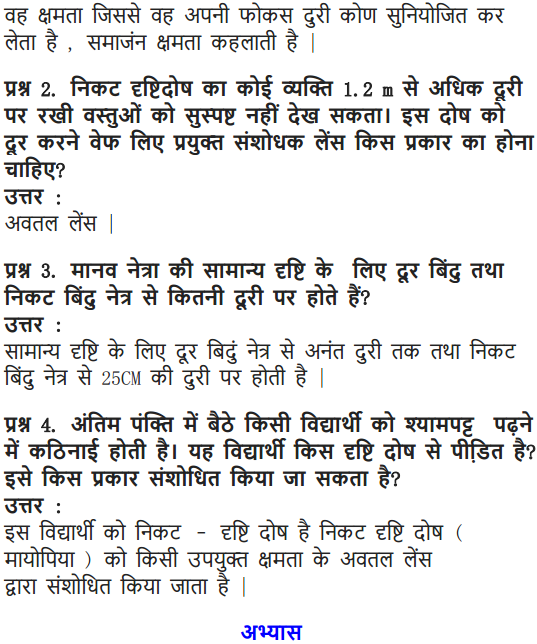
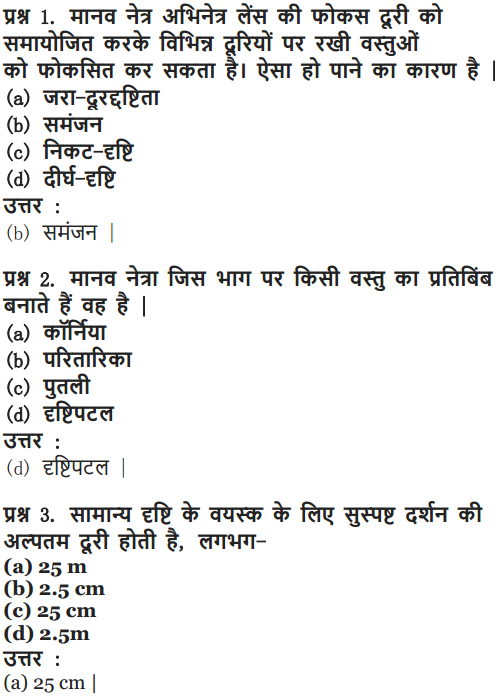
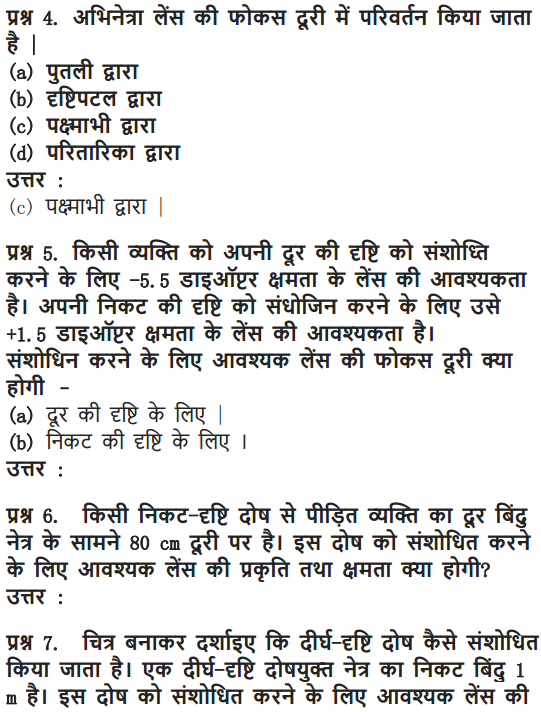
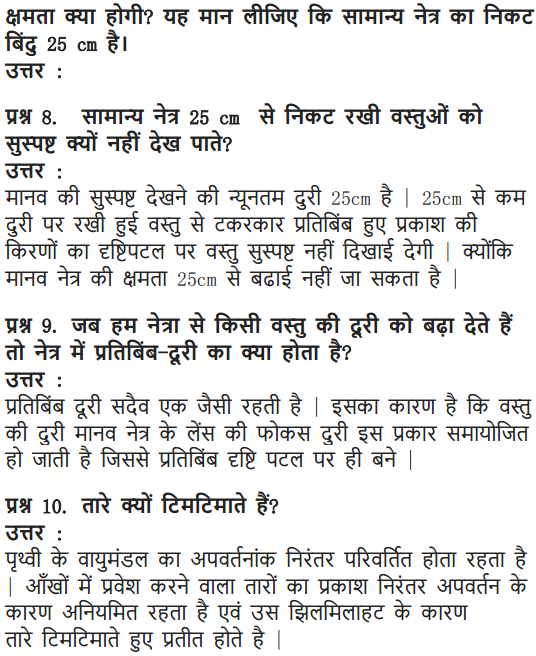
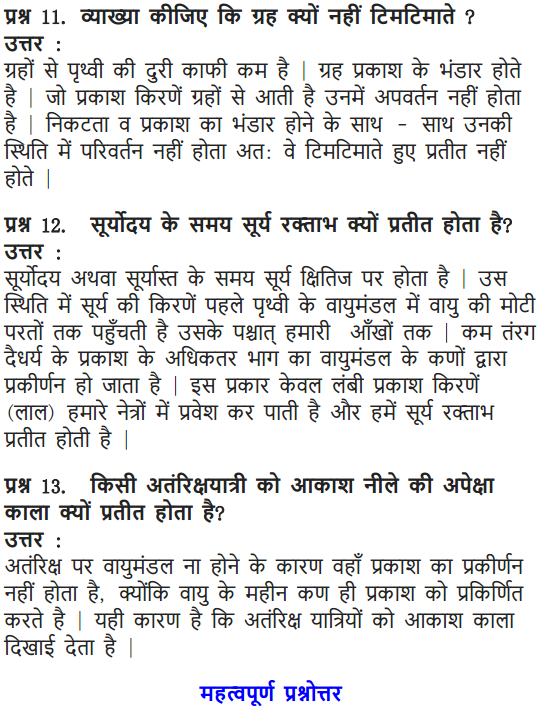
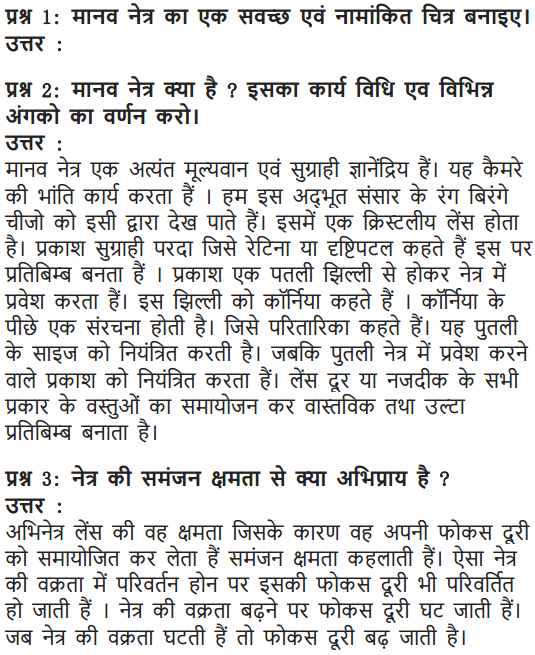
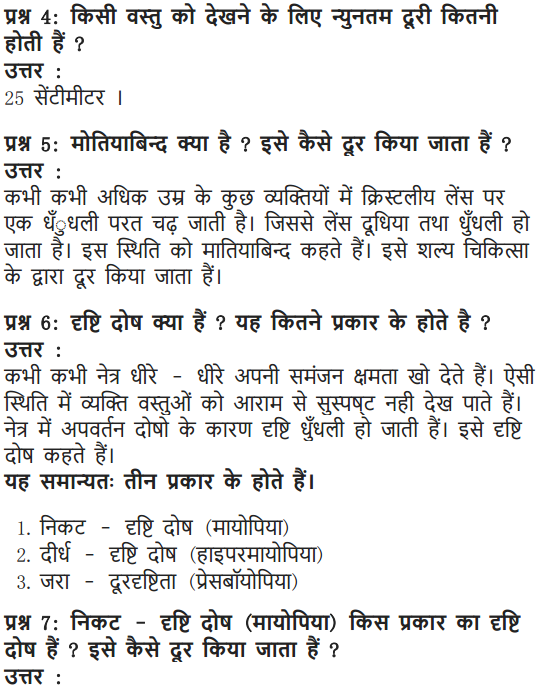
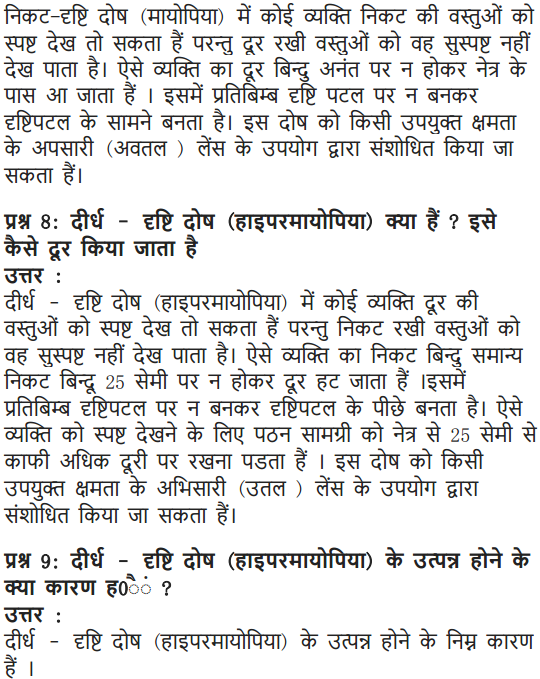

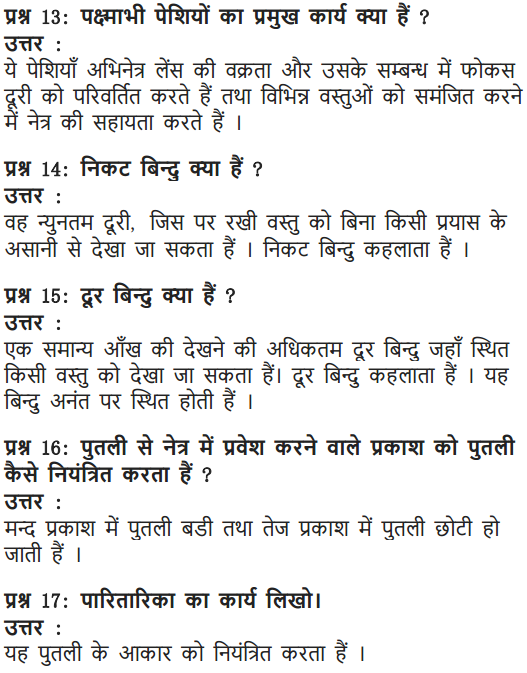
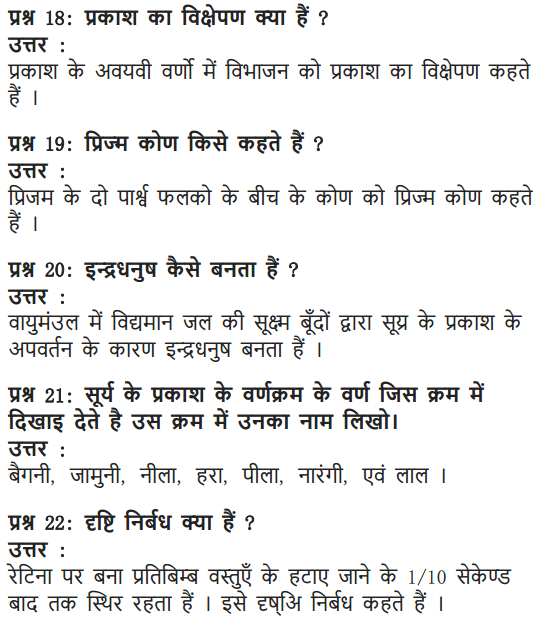
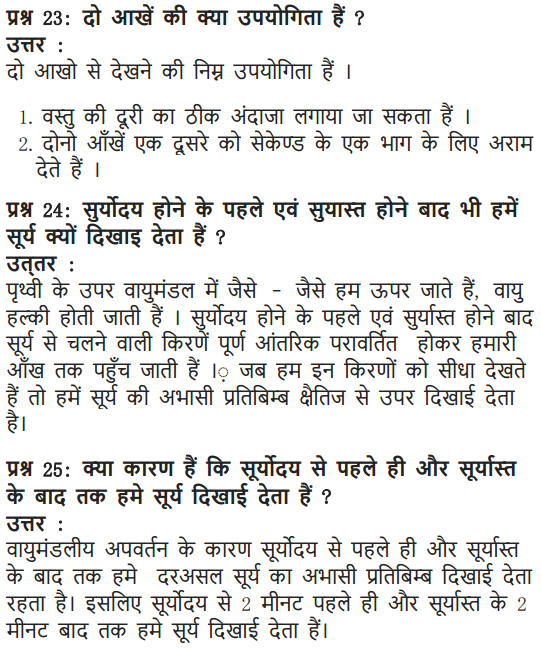
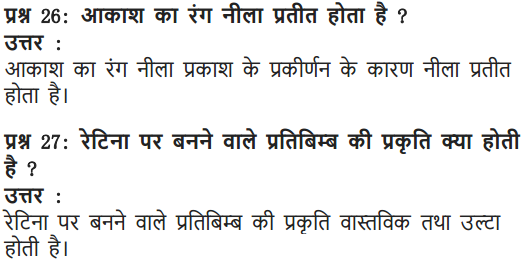
Class 10 Science Human Eye and Colourful World Mind Map
Human Eye
The organ which gives us the sense of light or enables us to see. It interprets the shapes, colours and dimensions of the
Parts of the Human Eye
Retina: It is a light sensitive screen on which image is formed.
It contains rods sensitive to intensity of light and cones sensitive to colour.
Cornea: Thin membrane acts like a lens which allow light to enter the eye.
Sclera: Outer part of the eye, protects interior of the eye.
Eye Lens: Convex lens made of transparent, crystalline and flexible jelly like material.
Refractive index of eye lens is 1.437
Ciliary Muscles: Modify the shape of eye lens.
Pupil: Hole in the middle of iris through which light enters.
Iris: Controls the amount of light entering the eye by changing the size of pupil.
Optical Nerve: Nerves take the image to the brain in the form of electrical signals.
Defects of Human Eye
Myopia or Short Sightedness: can see nearby objects but cannot see far off objects distinctly. Corrected by using a concave lens.
Hypermetropia or Long Sightedness: can see far off objects clearly but cannot see nearby objects clearly. Corrected by convex lens
Presbyopia: It is due to lessening of the flexibility of the crystalline lens and weakening of ciliary muscles. Corrected by using bifocal lenses.
Astigmatism: Refractive problem responsible for blurry vision. Corrected by using cylindrical lenses.
Cataract: It is a clouding of the lens in the eye. Corrected using cataract surgery
Power of Accommodation
The ability of the eye lens to adjust its focal length so as to see the objects clearly located anywhere. Near point of the human eye is 25 cm and far point of the human eye is infinity.
| Object | Ciliary muscles | Suspensory ligaments | Muscle tension on lens | Lens shape |
| Near | Contract | Slackened | Low | Thick |
| Distant | Relax | Stretched | High | Thin |
Persistence of Vision
Image of any object seen persists on the retina for 1/16 second even after the removal of the object. This property is used in cinematography.
Reason for Hypermetropia
- Increase in focal length of eye lens
- Shortening of eye-ball

Reason for Myopia
- Excessive curvature of cornea
- Elongation of eye-ball
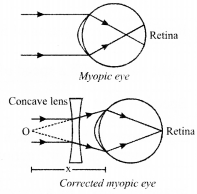
Refraction
Bending of light when it passes obliquely from one medium to another medium
Dispersion
Splitting of white light into its component colours – VIBGYOR.
Red colour deviates least and violet deviates most
Cause of Dispersion
Refractive index of material for different wavelengths is different.
µ ∝
Spectrum
Band of seven component colours VIBGYOR on a white screen
Rainbow
Seven colours band of sunlight in the form of bow in the sky. It is formed due to reflection, refraction and dispersion of sunlight by tiny water droplets. To observe rainbow, observer should stand with its back towards sun.
Colour
The sensation received by the eye (rod cells of the eye) due to light coming from an object.
Primary Rainbow
- Two refraction and one total internal reflection
- Subtends an angle of 42° at the eye of the observer
- Innermost arc is violet and outermost is red
- More bright
Secondary Rainbow
- Two refraction and two total internal reflection
- Subtends an angle of 52.5° at the eye
- Innermost arc is red and outermost is violet
- Less bright in comparison to primary rainbow
Atmospheric Refraction
Phenomena due to Refraction of light by atmosphere
- Twinkling of stars
- Stars seen higher than they actually are
- Advance sunrise and delayed sunset
- Flattering of the sun at morning and evening
Scatttering of Light
- Rayleigh scattering Intensity of scattered light ∝ 1/λ4
- Tyndall effect The smoke particles become visible
- The reddening of the sun at sunrise and sunset
- Blue colour of sky
- The sky looks dark in absence of atmosphere
- Danger signals are of red coloured
Important Questions of Light Reflection and Refraction Class 10 Science Chapter 11
Question 1.
State one function of iris in human eye. (AI 2012)
Answer:
Irish adark muscular diaphragm that controls the size of the pupil.
Question 2.
State one function of the crystalline lens in the human eye. (Foreign 2012)
Answer:
The crystalline lens of human eye focuses the light that enters the eye and form the image on the retina.
Question 3.
Define the term power of accommodation. Write the modification in the curvature of the eye lens which enables us to see the nearby objects clearly? (Delhi 2019)
Answer:
The ability of the eye lens to adjust its focal length is called power of accommodation. The ciliary muscles modifies the curvature to some extent. The change in the curvature of the eye lens can thus change its focal length. When the ciliary muscles contract, the lens becomes thick and its focal length decreases, thus enables us to see nearby objects clearly.
Question 4.
Trace the sequence of events which occur when a bright light is focused on your eyes. (Delhi 2019)
Answer:
When a bright light enters the eye then most of the refraction for the light rays entering the eye occurs at the outer surface of the cornea. Then, the crystalline lens merely provides the finer adjustment of focal length required to focus object at different distances on the retina. The pupil regulates and controls the amount of light entering the eye. At retina, the light-sensitive cells get activated upon illumination and generate electric signals. These signals are sent to the brain via the optic nerves. The brain interprets these signals and finally, processes the information so that we perceive objects as they are.
Question 5.
Write about power of accommodation of human eye. Explain why the image distance in the eye does not change when we change the distance of an object from the eye? (Delhi 2017)
Answer:
The ability of the eye lens to adjust its focal length is called power of accommodation.
The ciliary musqles modifies the curvature to some extent. The change in the curvature of the eye lens can thus change its focal length. Thus, the focal length of the human lens increases or decreases depending on the distance of the object value to this distance of the image does not change. For example, when the ciliary muscles are relaxed, the lens becomes thin and its focal length increases, thus enables us to see distant object clearly.
Question 6.
State the function of each of the following parts of human eye:
(i) Cornea
(ii) Iris
(iii) Pupil (1.5/3, Delhi 2013 C)
Answer:
(i) Cornea : It is a transparenl bulge on the front surface of eyeball which refracls most ol lhe light rays entering the eye.
(ii) Iris : Refer to answer 1.
(iii) Pupil: It controls the amount of light entering into the eye.
Question 7.
Write the function of each of the following parts of human eye:
(i) Cornea (ii) Iris (iii) Crystalline lens (iv) Ciliary muscles (2/5, 2018, Delhi 2016)
Answer:
(i) Cornea : Refer to answer 6(i).
(ii) Iris : Refer to answer 1.
(iii) Crystalline lens : Refer to answer 2.
(iv) Ciliary muscles: Ciliary muscles holds the eye lens and helps in the adjustment of its focal length.
Question 8.
State the function of each of the following parts of the human eye :
(i) Cornea (ii) Iris (iii) Pupil (iv) Retina (2/5, Foreign 2015)
Answer:
(i) Cornea : Refer to answer 6(i).
(ii) Iris : Refer to answer 1.
(iii) Pupil: Refer to answer 6(iii).
(iv) Retina: It capture light and convert it into electric signals that are translated into images by the brain.
Question 9.
(a) List the parts of the human eye that control the amount of light entering into it. Explain how they perform this function?
(b) Write the function of retina in human eye. (3/5, AI2014)
Answer:
(a) The part of the human eye that controls the amount of light entering into it is pupil.
Light enters the eye through a thin membrane called the cornea. It forms the transparent bulge on the front surface of the eyeball most of the refraction for the light rays entering the eye occurs at the outer surface of the cornea, the crystalline lens merely provides the linear adjustment of focal length required to focus objects at different distances on the retina. Iris which is behind the cornea controls the size of the pupil. The pupil regulates and controls the amount of light entering the eye.
(b) Refer to answer 8(iv).
Question 10.
Person suffering from cataract has
(a) elongated eyeball
(b) excessive curvature of eye lens
(c) weakened ciliary muscles
(d) opaque eye lens
Answer:
(d) A person suffering from cataract has cloudy opaque eye lens.
Question 11.
(a) List two causes of hypermetropia.
(b) Draw ray diagrams showing (i) a hypermetropic eye and (ii) its correction using suitable optical device. (2020)
Answer:
(a) Hypermetropia is caused due to following reasons:
(i) Shortening of the eyeball
(ii) Focal length of crystalline lens is too long.
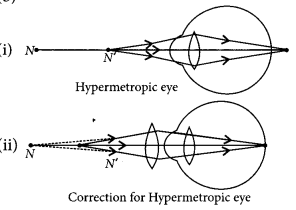
Question 12.
(a) A person is suffering from both myopia and hypermetropia.
(i) What kind of lenses can correct this defect?
(ii) How are these lenses prepared?
(b) A person needs a lens of power +3 D for correcting his near vision and -3 D for correcting his distant vision. Calculate the focal lengths of the lenses required to correct these defects. (2020)
Answer:
(a) (i) The lens which can correct the vision of such a person suffering from both myopia and hypermetropia is a bifocal lens.
(ii) A common type of bifocal lens contains both concave and convex lens. It is prepared with the upper portion consisting of a concave lens facilitating distant vision and the lower portion consisting of convex lens facilitating near vision, (b) The power for correcting his near vision,
PN = +3 D.
As P =
∴ Focal length of convex lens needed,
fN =
Power required to correct distant vision, PD = -3D
∴ Focal length of concave lens,
fD =
Question 13.
A person may suffer from both myopia and hypermetropia defects.
(a) What is this condition called?
(b) When does it happen?
(c) Name the type of lens often required by the persons suffering from this defect. Draw labelled diagram of such lenses. (2020)
Answer:
(a) This condition is called presbyopia.
(b) It happens due to gradual weakening of ciliary muscles and diminishing flexibility of eye lens due to agening.
(c) It can be corrected by using bifocal lenses.
Question 14.
What eye defect is myopia? Describe with a neat diagram how this defect of vision can be corrected by using a suitable lens. (AI 2011)
Answer:
Myopia is also known as near-sightedness. A person with myopia can see nearby objects clearly but cannot see distant objects distinctly.
Myopia can he corrected by using concave lens of appropriate local length.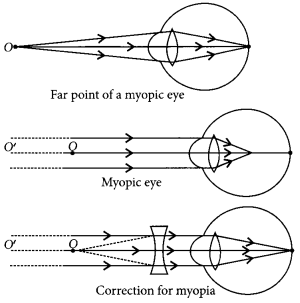
Question 15.
Name the three common defects of vision. What are their causes? Name the type of lens used to correct each of them. (Foreign 2011)
Answer:
Three common defects of vision are
- Myopia
- Hypermetropia
- Presbyopia
Myopia can be caused due to following reasons.
- Elongation of eyeball.
- Excessive curvature of eye lens.
Hypermetropia can be caused due to following reasons.
- Shortening of eyeball.
- Focal length of eye lens becomes too long.
Presbyopia is caused due to gradual weakening of ciliary muscles and diminishing flexibility of eye lens due to ageing.
Correction of these defects:
- Myopia can be corrected by using concave lens of appropriate focal length.
- Hypermetropia can he corrected by using convex lens of appropriate local length.
- Presbyopia can be corrected by using bifocal lens.
Question 16.
A student is unable to see clearly the words written on the black board placed at a distance of approximately 3 m from him. Name the defect of vision the boy is suffering from. State the possible causes of this defect and explain the method of correcting it. (3/5, 2018)
Answer:
Student is suffering from myopia.
The two possible reasons due to which the defect of vision arises are : excessive curvature of the eye lens and elongation of the eye ball.
A student with myopia has the far point nearer than infinity, thus, the image of a distant object is formed in front of the retina.
Correction of myopia: This defect can be corrected by using a concave lens of suitable power as it brings the image back on to the retina, thus the defect is corrected.
Question 17.
A student suffering from myopia is not able to see distinctly the objects placed beyond 5 m.
(a) List two possible reasons due to which this defect of vision may have arisen. With the help of ray diagrams, explain
(i) Why the student is unable to see distinctly the objects placed beyond 5 m from his eyes?
(ii) The type of the corrective lens used to restore proper vision and how this defect is corrected by the use of this lens.
(b) If, in this case, the numerical value of the focal length of the corrective lens is 5 m, find the power of the lens as per the new Cartesian sign convention. (AI 2017)
Answer:
(a) Refer to answer 16.
(b) Focal length, f = -5 m
P =
Hence, the power is – 0.2 D.
Question 18.
Millions of people of the developing countries of world are suffering from corneal blindness. These persons can be cured by replacing the defective cornea with the cornea of a donated eye. A charitable society of your city has organised a campaign in your neighbourhood in order to create awareness about this fact. If you are asked to participate in this mission how would you contribute in this noble cause?
(a) State the objective of organising such campaigns.
(b) List two arguments which you would give to motivate the people to donate their eyes after death.
(c) List two values which are developed in the persons who actively participate and contribute in such programmes. (VBQ, 3/5, Delhi 2016)
Answer:
We can encourage people to participate in the camp and also register ourselves as a donator.
(a) The objective of organising such campaign is to make people aware and realize their duties towards society.
(b) (i) By donating our eyes after we die, we can light the life of a blind person.
(ii) One pair of eyes gives vision to two corneal blind people.
(c) (i) It shows the concern for others.
(ii) It also shows the responsible behavior towards the society.
Question 19.
A student is unable to see clearly the words written on the blackboard placed at a distance of approximately 4 m from him. Name the defect of vision the boy is suffering from.
Explain the method of correcting this defect. Draw ray diagram for the
(i) defect of vision and also
(ii) for its correction (Delhi 2015)
Answer:
Refer to answer 16.
Question 20.
Write the importance of ciliary muscles in the human eye. Name the defect of vision that arises due do gradual weakening of the ciliary muscles in old age. What type of lenses are required by the persons suffering from this defect to see the objects clearly?
Akshay, sitting in the last row in his class, could not see clearly the words written on the blackboard. When the teacher noticed it, he announced if any student sitting in the front row could volunteer to exchange his seat with Akshay. Salman immediately agreed to exchange his seat with Akshay. He could now see the words written on the blackboard clearly. The teacher thought it fit to send the message to Akshay s parents advising them to get his eyesight checked.
In the context of the above event, answer the following questions:
(a) Which defect of vision is Akshay suffering from? Which type of lens is used to correct this defect?
(b) State the values displayed by the teacher and Salman.
(c) In your opinion, in what way can Akshay
express his gratitude towards the teacher and Salman? (VBQ, AI 2015)
Answer:
Ciliary muscles modifies the curvature of eye lens and hence adjusts its focal length. I his enables us to see objects.
The defect of vision arises due to weakening of ciliary muscles in old age is presbyopia, person suffering from this defect should wear bifocal lenses. These lenses consists of both concave and convex lenses.
(a) Akshay is suffering from myopia or near-sightedness. He should use concave lens to correct this defect.
(b) Teacher and Salman are concerned and caring.
(c) Akshay can show his gratitude by saying thank you.
Question 21.
Millions of people of the developing countries are suffering from corneal blindness. This disease can be cured by replacing the defective cornea with the cornea of a donated eye. Your school has organised a campaign in the school and its neighbourhood in order to create awareness about this fact and motivate people to donate their eyes after death. How can you along with your classmates contribute in this noble cause? State the objectives of organising such campaigns in schools. (VBQ, 3/5, Foreign 2015)
Answer:
Refer to answer 18.
Question 22.
Do you know that the corneal-impairment can be cured by replacing the defective cornea with the cornea of the donated eye?
How and why should we organise groups to motivate the community members to donate their eyes after death? (2/5, AI 2014)
Answer:
Yes, we know that the corneal – impairment can be cured by replacing the objective cornea with the cornea of the donated eye. We can provide the importance of eye donation to the community members. Our eyes can live even after our death. By donating our eyes after die, we can light the life of a blind person. The human eye is one of the most valuable and sensitive sense organs. It enables us to see the wonderful world and colours around us. It is however, impossible to identify colours while closing the eyes. Thus of all the sense organs, the human eye is the most significant one as it enables as to see the beautiful colourful word around us. Hence, we should donate our eyes after death.
Question 23.
What is myopia? List two causes for the development of this defect? How can this defect be corrected using a lens? Draw ray diagrams to show the image formation in case (i) defective eye and (ii) corrected eye. (Foreign 2014)
Answer:
Myopia is also known as near-sightedness defect in which a person can see nearby objects clearly but cannot see distant objects distinctly. This defect may arise due to
(a) excessive curvature of the eye.
(b) elongation of the eye ball.
This defect can be corrected by using a concave lens of suitable power.
Refer to answer 16.
Question 24.
(a) A person cannot read newspaper placed nearer than 50 cm from his eyes. Name the defect of vision he is suffering from. Draw a ray diagram to illustrate this defect. List its two possible causes. Draw a ray diagram to show how this defect may be corrected using a lens of appropriate focal length.
(b) We see advertisements for eye donation on television or in newspapers. Write the importance of such advertisements. (Delhi 2013)
Answer:
(a) The person is suffering from hyperme-tropia.
Hypermetropia : It is a defect in an eye in which a person is not able to see nearby object distinctly but can see far objects clearly.
Refer to answer 11.
(b) It is important to advertise for eye donation on television or in newspaper because
(i) Few people are unaware about the fact that there can be an eye transplant through which blind people can see this colourful and beautiful world.
(ii) To encourage them to donate their eye by spreading awareness about it through television or newspaper.
Question 25.
A student cannot see a chart hanging on a wall placed at a distance of 3 m from him. Name the defect of vision he is suffering from. How can it be corrected? Draw ray diagrams for the (i) defect of vision and also
(ii) for its correction. (Delhi 2012)
Answer:
Refer to answer 16.
Question 26.
An old man cannot see objects closer than 1 m from the eye clearly. Name the defect of vision he is suffering from. How can it be corrected? Draw ray diagram for the (i) defect of vision and also (ii) for its correction. (AI 2012)
Answer:
He is suffering from hypermetropia. Refer to answer 24 (a).
Question 27.
Draw a diagram to show why distant objects cannot be seen distinctly by a myopic eye. List two reasons due to which this defect of vision may be caused.
A person with a myopic eye cannot see objects clearly beyond a distance of 2 m. Name the type of the corrective lens that would be needed to correct the defect of vision and draw a ray diagram to show how the defect gets corrected. (Foreign 2012)
Answer:
Refer to answer 16.
Question 28.
Draw a ray diagram to show the refraction of light through a glass prism. Mark on it (a) the incident ray, (b) the emergent ray and (c) the angle of deviation. (AI 2011)
Answer: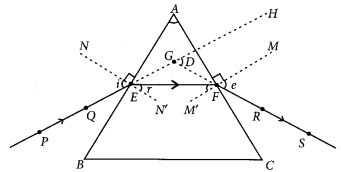
i = angle of incidence
(a) PE = incident ray
(b) FS = emergent ray
(c) ∠D = angle of deviation
Question 29.
Draw a ray diagram to explain the term angle of deviation. (1/5, Delhi 2017)
Answer:
The emergent ray bends at an angle to the direction of the’incident, thus the angle between them is known as angle of deviation (D).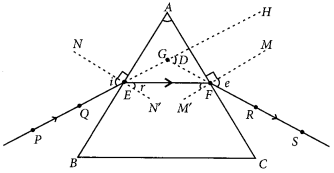
Question 30.
Draw a labelled diagram to explain the formation of a rainbow in the sky. (Foreign 2015)
Answer:
A rainbow is a natural spectrum caused by dispersion of sunlight by tiny water droplets, present in the atmosphere.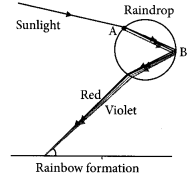
Point A denotes dispersion and point B denotes internal reflection.
Question 31.
How will you use two identical glass prisms so that a narrow beam of white light incident on one prism emerges out of the second prism as white light? Draw and label the ray diagram. (2020)
Answer:
Newton was the first to use a glass prism to obtain the spectrum of a white light. He then placed a second identical prism in an inverted position with respect to the first prism. This allowed all the colours of the white light to pass through the second prism combining to form a white light emerging from the other side of the second prism. This made him believe that white light was composed of different colours.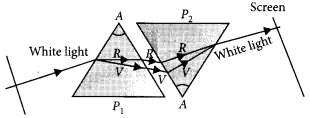
Question 32.
Differentiate between a glass slab and a glass prism. What happens when a narrow beam of
(i) a monochromatic light and (ii) white light passes through (a) glass slab and (b) glass prism? (2020)
Answer:
Glass slab:
- It is a substance made of glass having three dimension and has cuboidal structure.
- It does not deviate the path of light falling on it but produces a lateral displacement of the light ray after refraction. The incident and emergent ray are parallel to each other.
Glass prism:
- A prism is a structure made of glass with two triangle bases and three rectangular lateral surfaces. These surfaces are inclined to each other.
- A prism deviates the path of light ray falling on it. Here the incident ray and emergent ray are not parallel to each other.
(i) When a narrow beam of monochromatic light falls on a
(a) glass slab, it gets refracted at its surface and the emergent ray is laterally displaced from the incident ray.
(b) prism, it gets refracted at the surface and the light gets deviated from its initial path. The angle between the incident ray and emergent ray is known as angle of deviation.
(ii) When a white light passes through a
(a) glass slab, the light does not undergo dispersion as its two refracting surfaces are parallel to each other. The white light is laterally displaced from its initial path.
(b) prism, the white light undergoes dispersion and splits into its constituent colours along with deviation from its initial path.
Question 33.
(a) With the help of labelled ray diagram show the path followed by a narrow beam of monochromatic light when it passes through a glass prism.
(b) What would happen if this beam is replaced by a narrow beam of white light? (2020)
Answer: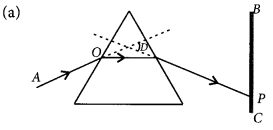
Here, in the figure, ∠D is the angle of deviation of the given monochromatic light by the glass prism.
(b) If AO were a ray of white light, then on screen BC, a spectrum will be observed, consisting of seven colours arranged from bottom to top as follows. Violet, Indigo, Blue, Green, Yellow, Orange, Red (VIBGYOR)
Question 34.
What is rainbow? Draw a labelled diagram to show the formation of a rainbow. (Delhi 2019)
Answer:
After a rain-shower, the sunlight gets dispersed by tiny droplets, present in the atmosphere. The water droplets acts like small glass prisms. They refract and disperse the incident sunlight, then reflect it internally, and finally refract it again when it comes out of the raindrop. Due to dispersion of light and internal reflection, different colours reaches the observers eye, which is called a rainbow.
Refer to answer 30.
Question 35.
What is ‘dispersion of white light’? State its cause. Draw a ray diagram to show the dispersion of white light by a glass prism. (AI 2017)
Answer:
Splitting of white light into its seven constituent colours due to refraction is known as dispersion of white light.
Cause of dispersion : When a beam of white light enters a prism, it gets refracted and splits into seven constituent colours. The splitting of the light ray occurs due to the different bending angle for each colour. Thus, each colour ray when passing through the prism bends at different angles with respect to the incident beam, thus giving rise to a spectrum.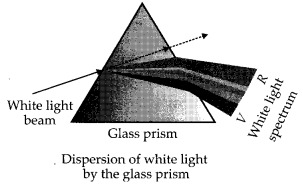
Question 36.
State the cause of dispersion of white light passing through a glass prism. How did Newton showed that white light of sun contains seven colours using two identical glass prisms. Draw a ray diagram to show the path of light when two identical glass prisms are arranged together in inverted position with respect to each other and a narrow beam of white light is allowed to fall obliquely on one of the focus of the first prism. (Delhi 2016)
Answer:
Refer to answer 35 and 31.
Question 37.
Describe an activity to show that the colours of white light splitted by a glass prism can be recombined to get white light by another identical glass prism. Also draw ray diagrams to show the recombination of the spectrum of white light. (AI 2016)
Answer:
Refer to answer 31.
Question 38.
A narrow PQ of white light is passing through a glass prism ABC as shown in the diagram. Trace it on your answer sheet and show the path of the emergent beam as observed on the screen DE.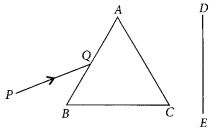
(i) Write the name and cause of the phenomenon observed.
(ii) Where else in nature is this phenomenon observed?
(iii) Based on this observation, state the conclusion which can be drawn about the constituents of white light. (AI 2014)
Answer: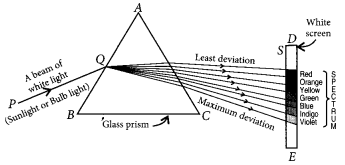
(i) The phenomenon of the splitting up of the white light into its constituents colours is called dispersion of light. Dispersion of light is caused due to, different constituents colours of light after different refractive indices to the material of the prism.
(ii) The formation of rainbow is caused by the dispersion of the white sunlight into its constituent colours.
(iii) Based on the dispersion of white light into its constituents colours, we can conclude that
(a) The white light consists of seven colours.
(b) The violet light Millers maximum deviations and the red light suffers minimum deviation.
Question 39.
Define the term dispersion of white light. Name the colour of light which bends (i) the most, (ii) the least while passing through a glass prism. Draw a ray diagram to justify your answer. (Foreign 2014)
Answer:
Refer to answer 38.
Question 40.
What is a spectrum? How can we recombine the components of white light after a glass prism has separated them? Illustrate it by drawing a diagram. (Foreign 2014)
Answer:
Refer to answer 36.
Question 41.
When we place a glass prism in the path of a narrow beam of white light, a spectrum is obtained. What happens when a second identical prism is placed in an inverted position with respect to the first prism? Draw a labelled diagram to illustrate it. (Delhi 2012)
Answer:
Refer to answer 31.
Question 42.
Draw a labelled ray diagram to illustrate the dispersion of a narrow beam of white light when it passes through a glass prism. (AI 2012)
Answer:
Refer to answer 35.
Question 43.
Draw a ray diagram to show the formation of a rainbow and mark the point where
(i) dispersion, (ii) internal reflection occurs. (Foreign 2012)
Answer:
Refer to answer 30.
Question 44.
What is meant by the dispersion of white light? Draw a diagram to show dispersion of white light by the glass prism. (Delhi 2011)
Answer:
Refer to answer 35.
Question 45.
Explain the formation of rainbow in the sky with the help of a diagram. (Foreign 2011)
Answer:
Refer to answer 30.
Question 46.
Give reasons:
(i) The extent of deviation of a ray of light on passing through a prism depends on the colour.
(ii) Lights of red colour are used for danger signals. (Foreign 2011)
Answer:
(i) The extent of deviation of a ray of light on passing through a prism depends on the colour because the refractive index of glass for different colour is different. It depends on wavelength of a particular light.
(ii) Since the wavelength of light is maximum in the spectrum, its penetration power in the air is maximum and so we can see red colour from farther distances. Thus, danger signal uses red colour.
Question 47.
(a) Why do the component colours of incident white light split into a spectrum while passing through a glass prism, explain.
(b) Draw a labelled ray diagram to show the formation of a rainbow. (4/5, Delhi 2017)
Answer:
(a) When a beam of light incidents on a prism, it first gets refracted and splits into seven constituent colors. The splitting of the light ray occurs due to the different bending angle for each colour. Thus each colour ray when passing through the prism bends at different angles with respect to the incident beam. This gives rise to the formation of the spectrum.
(b) Refer to answer 30.
Question 48.
(a) What is dispersion of white light? State its cause.
(b) “Rainbow is an example of dispersion of sunlight.” Justify this statement by explaining, with the help of a labelled diagram, the formation of a rainbow in the sky. List two essential conditions for observing a rainbow. (Foreign 2016)
Answer:
(a) Refer to answer 35.
(b) Refer to answer 34.
Two essential conditions for observing rainbow are
(i) Sun should be at the back of the observer.
(ii) Rainbow should be seen after rainfall or through a waterfall or water fountain.
Question 49.
(a) Trace on your answer sheet the path of a monochromatic ray AO incident on a glass prism and mark the angle of deviation.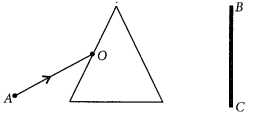
(b) If AO were a ray of white light,
(i) describe what will you observe on the screen BC placed near the prism
(ii) write the name of this phenomenon
(iii) state the cause of this phenomenon
(iv) what does it prove about the constituents of white light? (Delhi 2013 C)
Answer:
(a) Refer to answer 33(a)
(b) (i) Refer to answer 33(b)
(ii) This phenomenon is known as dispersion of light.
(iii) Refer to answer 35.
(iv) It proves that a white light consists of seven colours and lower the wavelength higher will be the deviation of light.
Question 50.
Why do stars appear to twinkle ? Explain. (Foreign 2015)
Answer: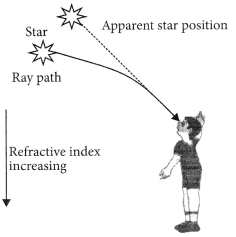
Due to atmospheric refraction, position of star visible from sun, is slightly different from its actual position. This apparent position of the star is not stationary, but keeps on changing with change in physical condition on earths atmosphere. Since the stars are very distant, they are approximately point-sized sources of light. As the path of rays of light coming from the star goes on varying slightly, the apparent position of the star fluctuates and the amount of starlight entering the eye flickers the star sometimes appears brighter, and at some other time, fainter, which is the twinkling effect.
Question 51.
Explain why the planets do not twinkle. (Foreign 2015)
Answer:
Planets do not emit light. However, they become visible due to reflection of light falling on them. The planets are much closer to the earth and thus can be considered as the extended source of light. The fluctuations in the light coming from various points of the planet due to atmospheric refraction get averaged out. As a result, no twinkling of planets is seen.
Question 52.
Explain in brief the reason for each of the following:
(a) Advanced sun-rise
(b) Delayed sun-set
(c) Twinkling of stars (Foreign 2016)
Answer:
(a, b): The Sun is visible to us about 2 minutes before the actual sunrise, and about 2 minutes after the actual sunset because of atmospheric refraction. By actual sunrise, we mean the actual crossing of the horizon by the Sun. Figure shows the actual and apparent positions of the Sun with respect to the horizon. The time difference between actual sunset and the apparent sunset is about 2 minutes. The apparent flattening of the Sun’s disc at sunrise and sunset is also due to the same phenomenon.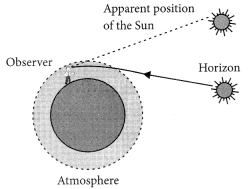
(c) Refer to answer 50.
Question 53.
What is meant by advance sunrise and delayed sunset? Draw a labelled diagram to explain these phenomena. (Foreign 2015)
Answer:
Refer to answer 52(a) and (b).
Question 54.
Explain with the help of a labelled diagram, the cause of twinkling of stars. (Delhi 2014)
Answer:
Refer to answer 50.
Question 55.
A star sometimes appears brighter and some other times fainter. What is this effect called? State the reason for this effect. (Delhi 2012)
Answer:
This effect is called twinkling of stars.
Refer to answer 50.
Question 56.
A star appears slightly higher (above) than its actual position in the sky. Illustrate it with the help of a labelled diagram. (AI2012)
Answer:
A star appears slightly above than its actual position in the sky. Since the starlight, on entering the earth’s atmosphere undergoes refraction continuously in a medium of gradually changing refractive index, before it reaches the earth. Since the atmosphere bends starlight towards the normal, the star appears slightly above than its actual position.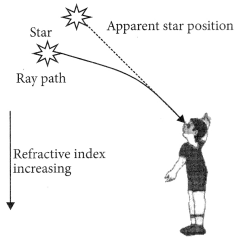
Question 57.
“The time difference between the actual sunset and the apparent sunset is about 2 minutes” What is the reason for the same? Explain with the help of a diagram. (Foreign 2012)
Answer:
Refer to answer 52(a) and (b).
Question 58.
Explain why the planets do not twinkle but the stars twinkle. (Delhi 2011)
Answer:
Refer to answer 50 and 51.
Question 59.
Why do stars twinkle ? Explain (2/3, 2018)
Answer:
Refer to answer 50.
Question 60.
What is atmospheric refraction? Use this phenomenon to explain the following natural events.
(a) Twinkling of stars
(b) Advanced sun-rise and delayed sun-set. Draw diagrams to illustrate your answers. (AI 2016)
Answer:
Refraction of the light by the different layers of the atmosphere having different refractive indices is known as atmospheric refraction.
(a) Twinkling of stars : Refer to answer 50.
(b) Advanced sun-rise and delayed sun-set : Refer to answer 52(a) and (b).
Question 61.
The sky appears dark to passengers flying at very high altitudes mainly because
(a) Scattering of light is not enough at such heights.
(b) There is no atmosphere at great heights.
(c) The size of molecules is smaller than the wavelength of visible light.
(d) The light gets scattered towards the earth. (2020)
Answer:
(b) There is no atmosphere at great heights.
Question 62.
Consider the following reasons for the reddish appearance of the sun at the sunrise or the sunset:
(A) Light from the sun near the horizon passes through thinner layers of air.
(B) Light from the sun covers larger distance of the earths atmosphere before reaching our eyes.
(C) Near the horizon, most of the blue light and shorter wavelengths are scattered away by the particles.
(D) Light from the sun near the horizon passes through thicker layers of air.
The correct reasons are
(a) A and C only
(b) B, C and D
(c) A and B only
(d) C and D only (2020)
Answer:
(b) Near the horizon, the light rays from the sun has to travel a larger distance through the Earth’s atmosphere as compared to when it is away from the horizon. Thus, when this light travels through the atmosphere, most of short wavelength lights are scattered away causing the reddish appearance of the sun.
Question 63.
What will be the colour of the sky when it is observed from a place in the absence of any atmosphere? (Delhi 2012)
Answer:
If the earth had no atmosphere, there would not have been any scattering. Then, the sky would look dark.
Question 64.
Give an example of a phenomenon where Tyndall effect can be observed. (AI 2011)
Answer:
The phenomenon of scattering of light by the colloidal particle give rise to Tyndall effect.
This phenomenon is seen when a fine beam of sunlight enters a smoke-filled room through a small hole. This can also be observed when sunlight passes through a canopy of a dense forest.
Question 65.
Why is the colour of clear sky blue? (Foreign 2011)
Answer:
When sunlight passes the atmosphere, the fine particles in air scatter blue colour more strongly than red. This scattered blue light enters our eye and the colour of clear sky appears blue.
Question 66.
Why is Tyndall effect shown by colloidal particles? State four instance of observing the Tyndall effect. (2020)
Answer:
The phenomenon of scattering of light by the colloidal particles give rise to Tyndall effect. When a beam of light strike colloidal particles, the path of the beam becomes visible. This is known as Tyndall effect.
This phenomenon can be observed when
- sunlight passes through a canopy of dense forest, when tiny water droplets in the mist scatter light.
- torch light is switched on in a foggy environment, light rays are visible after being scattered by the fog particles in the surrounding air.
- a fine beam of sunlight enters a smoke-filled room through a small hole.
- shining a flashlight beam into a glass of dilated milk produces Tyndall effect.
Question 67.
Draw a labelled diagram to show (i) reddish appearance of the sun at the sunrise or the sunset and (ii) white appearance of the sun at noon when it is overhead. (2020)
Answer: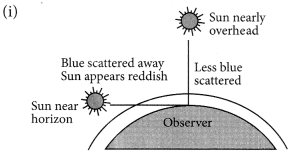
At sun-rise and the sun-set, light from the sun passes through thicker layers of air and larger distance in the earth’s atmosphere. As the red colour has longest wavelength hence, it is least scattered by the air and dust particles. So, the sun appears reddish.
(ii) At noon, when sun is overhead, the distance to be travelled is least. All wavelengths are scattered equally and hence sun appears white.
Question 68.
(a) State the relation between colour of scattered light and size of the scattering particle.
(b) The apparent position of an object, when seen through the hot air, fluctuates or waves. State the basic cause of this observation.
(c) Complete the path of white light when it passes through two identical prisms placed as shown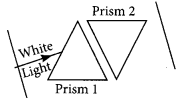
Answer:
(a) The colour of scattered light depends on the size of the scattering particle. Very fine particles scatter short wavelengths such as blue and violet, lights. Large size particles scatter light of longer wavelengths.
(b) The basic cause of this observation is atmospheric refraction. As hot air is less denser then the colder air surrounding it, it has a slightly lower refractive index. Since the physical condition of the refracting medium, in air is not stationary, the apparent position of an object, when seen through hot air fluctuates.
(c) Refer to answer 31.
Question 69.
With the help of a labelled diagram, explain why the sun appears reddish at the sun-rise and the sun-set. (Delhi 2015)
Answer:
Refer to answer 67(i).
Question 70.
What is meant by scattering of light? Use this phenomenon to explain why the clear sky appears blue or the sun appears reddish at sunrise. (AI 2015)
Answer:
The phenomenon by which a beam of light is redirected in many different directions when it interacts with a particle of matter is known as scattering of light.
Refer to answer 65 and 67(i).
Question 71.
Explain giving reason why the sky appears blue to an observer from the surface of the Earth. What should the appearance of the sky be during the day for an astronaut staying in the international space station orbiting the Earth? State reason to justify your answer. (Foreign 2015)
Answer:
Refer to answer 65.
For an astronaut staying in the international space station orbiting the Earth, the appearance of the sky will be black due to absence of air molecules to scatter the light coming from the Sun.
Question 72.
State the difference in colours of the sun observed during sunrise/sunset and noon. Give explanation for each. (Delhi 2013)
Answer:
During sunrise or sunset, the suns rays pass through a maximum length of the atmosphere. Most of the blue and shorter wavelength get scattered. Only the red colour of light reaches the observer. That is why the Sun observed during sunset and sunrise appear red. At noon, the distance to be travelled is least. All wavelengths are scattered equally and hence sun appears white.
Question 73.
Why does the sun appear reddish early in the morning? Will this phenomenon be observed by an astronaut on the Moon? Give reason to justify your answer. (3/5, 2018)
Answer:
Refer to answer 67(i).
This phenomenon cannot be seen by an astronaut on the moon because there is no atmosphere on moon to scatter the light.
CBSE Class 10 Science Notes Chapter 11 Human Eye and Colourful World
Human Eye: working of human eye, Persistence of vision, Power of accommodation of human eye, Defects of vision.
The Human Eye: It is a natural optical instrument which is used to see the objects by human beings. It is like a camera which has a lens and screen system.
Structure of the Human Eye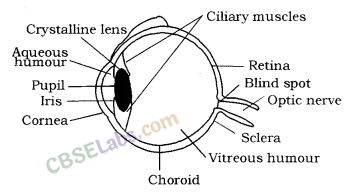
The various parts of eye and their functions :
- Retina: It is a light sensitive screen inside the eye on which image is formed. It contains rods and cones.
- Cornea: It is a thin membrane which covers the eye trail. It acts like a lens which refracts the light entering the eye.
- Aqueous humour: It is fluid which fills the space between cornea and eye lens.
- Eye lens: It is a convex lens made of transparent and flexible jelly like material. Its curvature can be adjusted with the help of ciliary muscles.
- Pupil: It is a hole in the middle of iris through which light enters the eye. It appears black because light falling on it goes into the eye and does not come back.
- Ciliary muscles: These are the muscles which are attached to eye lens and can modify the shape of eye lens which leads to the variation in focal lengths.
- Iris: It controls the amount of light entering the eye by changing the size of the pupil.
- Optical nerve: These are the nerves which take the image to the brain in the form of electrical signals.
The human eye is roughly spherical in shape with a diameter of about 2.3 cm. It consists of a convex lens made up of living tissues. Hence, human lenses are living organs contrary to the simple optical lenses. The following table lists the main parts of the human eye and their respective functions.
| S.No. | Human Eye Part | Functions |
| 1. | Pupil | Opens and closes in order to regulate and control the amount of light. |
| 2. | Iris | Controls light level similar to the aperture of a camera. |
| 3. | Sclera | Protects the outer coat. |
| 4. | Cornea | A thin membrane which provides 67% of the eye’s focusing power. |
| 5. | Crystalline lens | Helps to focus light into the retina. |
| 6. | Conjunctive | Covers the outer surface (visible part) of the eye. |
| 7. | Aqueous humour | Provides power to the cornea. |
| 8. | Vitreous humour | Provides the eye with its form and shape. |
| 9. | Retina | Captures the light rays focussed by the lens and sends impulses to the brain via the optic nerve. |
| 10. | Optic nerve | Transmits electrical signals to the brain. |
| 11. | Ciliary muscles | Contracts and extends in order to change the lens shape for focusing. |
How Pupil Works?
For Example, You would have observed that when you come out of the cinema hall after watching the movie in the bright sunlight, your eyes get closed. And when you entered the hall from the bright light, you won’t be able to see and after some time you would be able to see. Here, the pupil of an eye provides a variable aperture, whose size is controlled by iris.
(a) When the light is bright: Iris contracts the pupil, so that less light enters the eye.
(b) When the light is dim: Iris expands the pupil, so that more light enters the eye.
Pupil opens completely when iris is relaxed.
Persistence of Vision: It is the time for which the sensation of an object continue in the eye. It is about 1/16th of a second.
Power of Accommodation: The ability of the eye lens to adjust its focal length accordingly as the distances is called power of accommodation.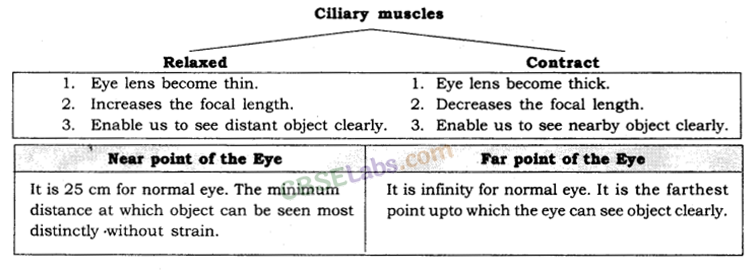
Colour Blindness: A person having defective cone cells is not able to distinguish between the different colours. This defect is known as Colour Blindness.
Defects of Vision and their Correction
Myopia (Short-sightedness): It is a kind of defect in the human eye due to which a person can see near objects clearly but he cannot see the distant objects clearly. Myopia is due to
(i) excessive curvature of the cornea.
(ii) elongation of eyeball.
Correction: Since a concave lens has an ability to diverge incoming rays, it is used to correct this defect of vision. The image is allowed to format the retina by using a concave lens of suitable power as shown in the given figure.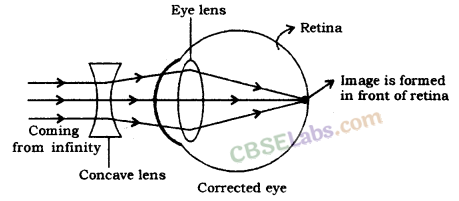
Hypermetropia (Long-sightedness): It is a kind of defect in the human eye due to which, a person can see distant objects properly but cannot see the nearby objects clearly. It happens due to
(i) decrease in the power of eye lens i.e., increase in focal length of eye lens.
(ii) shortening of eyeball.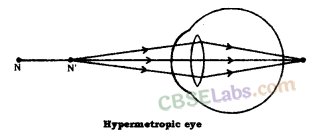
A hypermetropic eye has its least distance of distinct vision greater than 25 cm.
Correction: Since a convex lens has the ability to converge incoming rays, it can be used to correct this defect of vision, as you already have seen in the animation. The ray diagram for the corrective measure for a hypermetropic eye is shown in the given figure.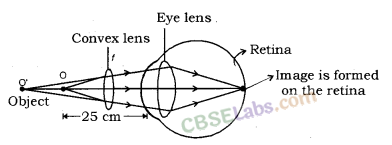
Power of the correcting convex lens:
The Lens formula,
In this case,
Object distance, u = ∞
Image distance, v =
person’s far point Focal length, f =?
Hence, lens formula becomes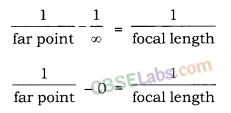
In case of a concave lens, the image is formed in front of the lens i.e., on the same side of the
object.
Focal length = -Far point
Now, power of the required lens (P) =
Power of the correcting convex lens: Lens formula,
Object distance, u = -25 cm, normal near point
Image distance, v = defective near point
Hence, the lens formula is reduced to
Presbyopia: It is a kind of defect in human eye which occurs due to ageing. It happens due to the following reasons
(i) decrease in flexibility of eye lens.
(ii) gradual weakening of ciliary muscles.
In this, a person may suffer from both myopia and hypermetropia.
Correction: By using a bifocal lens with appropriate power. Bifocal lenses consist of both concave and convex lens, upper position consists of the concave lens and lower portion consists of a convex lens.
Astigmatism: It is a kind of defect in human eye due to which a person cannot see (focus) simultaneously horizontal and vertical lines both.
Correction: By using a cylindrical lens.
Cataract: Due to the membrane growth over eye lens, the eye lens becomes hazy or even opaque. This leads to a decrease or loss of vision. This problem is called a cataract. It can be corrected only by surgery.
Refraction of light through a prism, Dispersion of white light by a glass prism, Composition of white light, Recombination of spectrum colours, Rainbow.
Refraction of light through a prism: When a ray of light is incident on a rectangular glass slab, after refracting through the slab, it gets displaced laterally. As a result, the emergent ray comes out parallel to the incident ray.
Unlike a rectangular slab, the side of a glass prism are inclined at an angle called the angle of prism.
Prism: A prism has two triangular bases and three
Angle of Prism: Angle between two lateral faces is
Angle of Deviation: The angle between the incident deviation.
Dispersion of white light by a glass prism: The phenomenon of splitting of white light into its seven constituent colours when it passes through a glass prism is called dispersion of white light. The various colours seen are Violet, Indigo, Blue, Green, Yellow, Orange and Red. The sequence of colours remembers as VIBGYOR. The band of seven colours is called the spectrum. The different component colour of light bends at a different angle with respect to the incident angle. The violet light bends the least while the red bends most.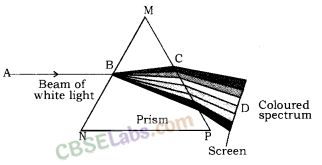
Composition of white light: White light consists of seven colours i.e., violet, indigo, blue, green, yellow, orange and red.
Monochromatic light: Light consisting of single colour or wavelength is called monochromatic light, example; sodium light.
Polychromatic light: Light consisting of more than two colours or wavelengths is called polychromatic light, example; white light.
Recombination of white light: Newton found that when an inverted prism is placed in the path of dispersed light then after passing through the prism, they recombine to form white light.
Issac Newton: He was the first, who obtained spectrum of sunlight by using glass prism. He tried to split the spectrum of white light more by using another similar prism, but he could not get any more colours.
He repeated the experiment using second prism in inverted position with respect to the first prism. It allowed all the colours of spectrum to pass through second prism. He found white light emerges on the other side of second prism.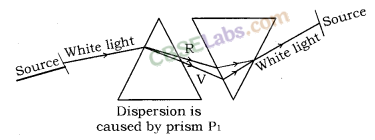
He concluded that Sun is made up of seven visible colour VIBGYOR.
Rainbow: It is the spectrum of sunlight in nature. It is formed due to the dispersion of sunlight by the tiny water droplet, present in the atmosphere.
Formation of the rainbow: The water droplets act like small prism. They refract and disperse the incident sunlight, then reflect it internally, and finally refract it again when it comes out of the raindrop. Due to the dispersion of light and internal reflection, different colours reach the observer’s eye.
Red colour appears on top and violet at the bottom of rainbow.
A rainbow is always formed in a direction opposite to that of Sun.
At ‘A’ – Refraction and dispersion take place.
At ‘B’ – Internal reflection takes place.
At ‘C’ – Refraction and dispersion take place.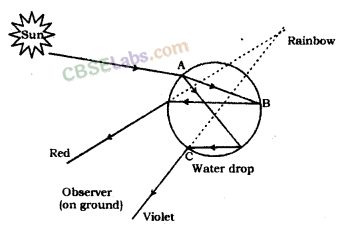
Atmospheric Refraction: The refraction of light caused by the Earth’s atmosphere (having air layers of varying optical densities) is called Atmospheric Refraction.
Appearance of Star Position: It is due to atmospheric refraction of star light.
The temperature and density of different layer of atmosphere keeps varying. Hence, we have different medium.
Distant star act as point source of light. When the starlight enter the Earth’s atmosphere, it undergoes refraction continuously, due to changing refractive index i.e. from Rarer to denser. It bends towards the normal.
Due to this, the apparent position of the star is different from actual position. The star appear higher than its actual position.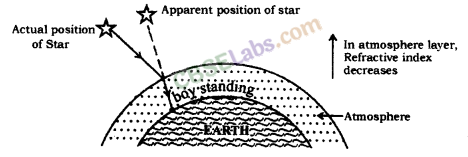
Twinkling of Star: It is also due to atmospheric refraction.
Distant star act like a point source of light. As the beam of starlight keeps deviating from its path, the apparent position of star keeps on changing because physical condition of earth’s atmosphere is not stationary.
Hence, the amount of light enters our eyes fluctuate sometimes bright and sometime dim. This is the “Twinkling effect of star”.
Why planets do not twinkle ?
Planets are closer to earth and are seen as extended source of light i.e. the collection of large number of point sized sources of light. Therefore the total amount of light entering our eyes from all individual point source will nullify the twinkling effect.
Why, the duration of day becomes approximately 4 minutes shorter if there is no atmosphere on earth: Actual sun rise happens when it is below the horizon in the morning. The rays of light from the sun below the horizon reach our eyes because of refraction of light. Similarly, the sun can be seen about few minutes after the actual sun set. Thus the duration of, day time will increase by 4 minutes.
This is due to atmospheric refraction. Because of this sun is visible about 2 minutes earlier than actual sunrise and about 2 minutes after the actual sun set.
Apparent flattering of the Sun’s disc at sunset and sunrise is due to atmospheric refraction.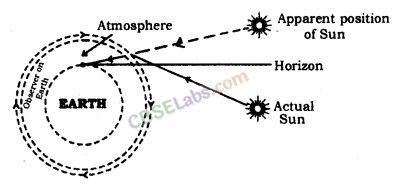
Scattering of light: According to Rayleigh’ Law of Scattering, the amount of scattered light ∝
Scattering of light decreases with increase in wavelength.
Tyndall Effect: When a beam of light strikes, the minute particle of earth’s atmosphere, suspended particles of dust and molecule of air the path of beam become visible. The phenomenon of scattering of light by the colloidal particle gives rise to Tyndall Effect.
It can be observed when sunlight passes through a canopy of a dense forest.
The colour of the scattered light depends on the size of the scattering particles.
Colour of Sunrise and Sunset: While sunset and sunrise, the colour of the sun and its surroundihg appear red. During sunset and sunrise, the sun is near to horizon, and therefore, the sunlight has to travel larger distance in atmosphere. Due to this, most of the blue light (shorter wavelength) is scattered away by the particles. The light of longer wavelength (red colour) reaches our eye. This is why sun appear red in colour.
Why the danger signal or sign is made of red colour?
Red colour scatteres the most when strikes the small particle of fog and smoke because it has the maximum wavelength (visible spectrum). Hence, from large distance also, we can see the red colour clearly.
At noon sun appears white: At noon, the sun is overhead and sunlight would travel shorter distance relatively through the atmosphere. Hence, at noon, the sun appear white as only little of the blue and violet colours are scattered.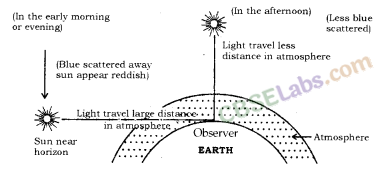
Human Eye: It is a wonderful gift of nature to the human body. Human eye is nearly spherical in shape of diameter about 2.5 cm.
Parts of Human Eye:
- Cornea: It is the protective and front layer of the eye. It is made by a transparent membrane. Light enters the eye through the cornea.
- Iris: Dark and a colourful muscular diaphragm is called iris. It is responsible for colour of the eye.
- Pupil: Small circular hole in the centre of iris. It regulates the amount of light entering the eye by adjusting the size of the iris.
- Ciliary Muscles: It holds the eye lens at its proper position. It changes the size of eye lens.
- Eye lens: The eye lens is a convex lens made by the transparent jelly like material.
- Retina: It is the screen of the eye. A real and inverted image form on the retina.
- Rods and Cones: These are colour sensitive rods and cones shaped cells. Rods are responsible for the vision in dim light while cones are responsible for colour.
- Optic Nerve: It converts information of the image into a corresponding electric signal and passes it to the brain.
- Blind Spot: The junction of the optic nerve and retina, where no rods and cones cells are present is called the blind spot. It is insensitive to light.
Near Point: The nearest point from eye at which the eye can see clearly without strain is called near point. For normal eye it is 25 cm.
Far Point: The farthest point, upto which the eye can see the object clearly is called far point. For normal eye it is infinity.
The range of Vision: Distance between near point and far point of eye is called range of vision.
Power of Accommodation: The ability of the eye to see near as well as far objects clearly is called Power of Accommodation.
Myopia (Nearsightedness): In this defect, the eye is unable to see far off objects clearly but is able to see near objects clearly.
Reason.
- Due to increase in size of eye ball
- Due to excessive curvature of cornea
- Due to increase in power (or decrease in focal length) of eye lens.
Correction: It is corrected by using concave lens of suitable focal length.
Hypermetropia (Far sightedness): In this defect eye is unable to see nearby objects clearly but is able to see far objects clearly.
Reason.
- Due to decrease in size of eye ball
- Due to decrease in power (or increase in focal length) of eye lens.
Correction: It is corrected by using a convex lens of suitable focal length.
Dispersion of Light: Splitting of white light into seven colours is called dispersion. Example, the formation of Rainbow (VIBGYOR). Violet deviates the most but red deviates least.
1. The human eye is one of the most valuable and sensitive sense organs. It enables us to see the wonderful world and the colours around us.
2. The eyeball is approximately spherical in shape with a diameter of about 2.3 cm.
3. Most of the refraction for the light rays entering the eye occurs at the outer surface of the cornea. The crystalline lens merely provides the finer adjustment of focal length required to focus.
4. The human eye has the following parts :
- Cornea : The transparent spherical membrane covering the front of the eye.
- Iris: The coloured diaphragm between the cornea and lens.
- Pupil: The small hole in the iris.
- Eye lens : It is a transparent lens made of jelly like material.
- Ciliary muscles: These muscles hold the lens in position.
- Retina: The back surface of the eye.
- Blind spot: The point at which the optic nerve leaves the eye. An image formed at this point is not sent to the brain.
- Aqueous humour: A clear liquid region between the cornea and the lens.
- Vitreous humour: The space between eye lens and retina is filled with another liquid called vitreous humour.
5. In the eye, the image is formed on the retina by successive refractions at the cornea, the aqueous humour, the lens and the vitreous humour. Electrical signals then travel along the optic nerve to the brain to be interpreted. In good light, the yellow spot is most sensitive to detail and the image is automatically formed there.
6. Accommodation: The ability of the eye to focus both near and distant objects, by adjusting its focal length, is called the accommodation of the eye or the ability of the ciliary muscles to change the focal length of the eye lens is called accommodation.
7. Defects of the Eye : Although the eye is one of the most remarkable organs in the body, it may have several abnormalities, which can often be corrected with eyeglasses, contact lenses, or surgery. The various defects from which an eye can suffer are (i) Hypermetropia or long sightedness, (ii) Myopia or shortsightedness and (iii) Astigmatism, (iv) Presbyopia.
8. Hypermetropia, hyperopia, or long sightedness : A person suffering from this defect can see distant objects I clearly but cannot see nearby objects clearly. In this defect, the near point lies farther away than 25 cm. Hypermetropia (far sightedness — the image of nearby objects is focussed beyond the retina) is corrected by using a convex lens of suitable power. The eye loses
its power of accommodation at old age.
9. Hypermetropia is due to the following reasons :
- Either the hyperopic eyeball is too short or
- The ciliary muscle is unable to change the shape
of the lens enough to properly focus the image i.e. the focal length of the eye lens increases.
10. Myopia or short sightedness or near sightedness: A person suffering frommyopia or short sightedness can see nearby objects clearly but cannot see the far away objects clearly. Myopia (short sightedness — the image of distant objects is focussed before the retina) is corrected by using a concave lens of suitable power.
11. This defect is due to the following reasons :
- Either the eyeball is longer than normal or
- The maximum focal length (due to excessive curvature of the cornea) of the lens is insufficient to produce a clearly formed image on the retina.
12. A person may also have an eye defect known as astigmatism, in which light from a point-source produces a line image on the retina. A person suffering from this defect cannot see in all directions equally well i.e., he cannot see the vertical and horizontal lines simultaneously. This condition arises either when the cornea or the crystalline lens or both are not perfectly spherical. Astigmatism can be corrected with lenses having different curvatures in two mutually perpendicular directions i.e., cylindrical lens.
13. When a person suffers from both, the myopia as well as Hypermetropia, his spectacles for correction have bifocal lenses. The upper half is a concave lens for distant vision and lower half is a convex lens for reading.
14. Presbyopia is that defect of human eye, due to which an old person cannot read and write comfortably. That is why Presbyopia is also called old sight.
15. To correct Presbyopia, an old person has to use spectacles with a convex lens of suitable focal length, or power as explained already.
16. The cause of Hypermetropia is decrease in length of eyeball or increase In focal length of eye lens. But the cause of Presbyopia is only increase in focal length of eye lens. The eyeball, in Presbyopia, has normal length.
the vision of the eye decreases, leading sometimes to total loss of vision. The problem is overcome by cataract surgery i.e., removal of the eye lens, and its replacement by a lens of suitable focal length.
18. We need two eyes because a human being has a horizontal field of view of about 150° with one eye and of about 180° with two eyes. Thus, two eyes provide us wider horizontal field of view.
With one eye, the world looks flat, i.e., two dimensional only. With two eyes, the view is three dimensional, i.e., dimension of depth is added to our view.
19. As our two eyes are separated by a few centimetres, each eye observes a slightly different image. Our brain combines the two views into one and we get to know how close or far away the things seen are.
20. By donating our eyes after we die, one pair of our eyes can give vision to two corneal blind people. Eye donors may belong to any sex or any age group. People suffering from diabetes, hypertension, asthma or any other non- communicable diseases can donate eyes. People who have been using spectacles or those operated for cataract can also donate eyes.
21. The smallest distance, at which the eye can see objects clearly without strain, is called the near point of the eye or the least distance of distinct vision. For a young adult with normal vision, it is about 25 cm.
22. Persistence of vision of the eye: The image of an object persists on the retina for 1/16 second, even after the removal of the object. The sequence of still pictures taken by a movie camera is projected on a screen at a rate of about 24 images or more per second. The successive impressions of images on the screen appear to merge smoothly into one another to give us the feeling of moving images.
23. The large numbers of light sensitive cells contained in the retina of the eye are of two types: rod shaped cells which respond to brightness or intensity of light and cone shaped cells, which respond to colour of light. Thus/cone shaped cells enable us to distinguish between different colours.
24. When a person cannot distinguish between different colours, he is said to be colour blind though his vision may otherwise be normal. Colour blindness is a genetic disorder which occurs by inheritance. So far, there is no cure for colour blindness.
25. Farpoint: The farthest point upto which a short sighted eye can see clearly is called the far point of the eye. For a normal eye, the far point is infinity.
26. Near point : The nearest point upto which a long sighted eye can see clearly is called the near point of the eye. For a normal human eye, of an adult, the near point is about 25 cm from the eye.
27. Least cfistance of distinct vision: The minimum distance upto which an eye can see clearly is called the legist distance of distinct vision ; it is normally denoted by D. The least distance of distinct vision is equal to the distance between the eye and its near point. For a normal human eye, this distance is around 25 cm.
28. The distance between far point and near point of the eye is called range of vision of the eye.
29. When white light passes through a prism, the violet light bends most and the red light bends the least. Dispersion of light is the phenomenon of splitting of white light into its constituent seven colours on passing through a glass prism. The band of seven colours so obtained is called visible spectrum.
30. The seven colours of white light are violet, indigo, blue, green, yellow, orange and red. It is remembered by the acronym VIBGYOR.
31. Isaac Newton was the first to use a prism to obtain a spectrum of sunlight.
32. Spectrum is the band of distinct colours we obtain when white light is split by a prism.
33. Cause of dispersion : Every colour has its own characteristic wavelength/frequency. Different colours move with same speed in air/vacuum. But their speeds in refracting media like glass are different. Therefore, refractive index of the medium for different colours is different. As a result, different colours undergo different deviations on passing through the prism. Hence, different colours emerge from the prism along different directions.
34. The speed of light in vacuum is same for all wavelengths, but the speed in a material substance is different for different wavelengths.
35. In any medium other than air/vacuum red light travels the fastest and violet light travels the slowest.
36. The most familiar form of electromagnetic radiation may be defined as that part of the spectrum that the human eye can detect. Light is produced by the rearrangement of electrons in atoms and molecules. The various wavelengths of visible light are classified with colours ranging from violet (λ = 4 x 10-7 m) to red (λ = 7 x 10-7 m). The eye’s sensitivity is a function of wavelength, the sensitivity being a maximum at a wavelength of about λ = 5.6 x 10-7 m (yellow-green).
37. When we pass white light through two ideptical prisms held side by side with their refracting edges in opposite directions; the first prism disperses white light into seven colours and the second prism recombines the seven colours into white light. Thus, light emerging from 2nd prism is white.
38. A rainbow is formed due to dispersion of light by tiny droplets of water which act as prisms.
39. Atmospheric refraction is the cause of twinkling of stars, advance sunrise and delayed sunset.
40. Scattering of light causes the blue colour of sky and the reddening of the Sun at sunrise and sunset.
NCERT Exemplar Class 10 Science Chapter 11 Human Eye and Colourful World
Short Answer Questions
Question 1. A student sitting at the back of the classroom cannot read clearly the letters written on the blackboard. What advice will a doctor give to her? Draw ray diagram for the correction of this defect.
Answer. The student is suffering from short-sightedness. Doctor will advise to her to wear a concave lens having suitable power for correcting the vision.
Question 2. How are we able to see nearby as well as the distant objects clearly?
Answer. Accommodation: The ability of the ciliary muscles to adjust the curvature and thereby the focal length to get clear view of objects is called accommodation. There is always a limit up to which ciliary muscles can increase or decrease the focal length of eye lens. This change enables us to see nearer and far-off objects clearly.
Question 3. A person needs a lens of power – 4.5 D for correction of her vision.
(a) What kind of defect in vision is she suffering from?
(b) What is the focal length of the corrective lens?
(c) What is the nature of the corrective lens?
Answer.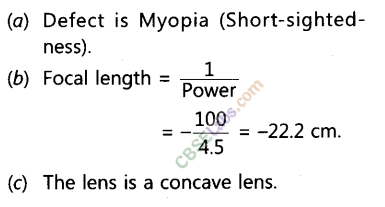
Question 4. How will you use two identical prisms so that a narrow beam of white light incident on one prism emerges out of the second prism as white light? Draw the diagram.
Answer. Consider a prism A. When white light falls on it, it splits into seven constituent colours. The violet colour deviates the most and red colour deviates the least, as shown.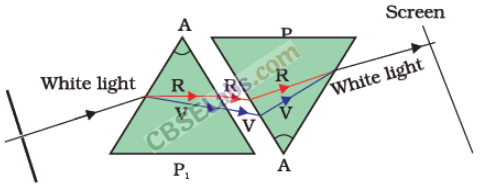
If another prism B is placed such that they are as shown below, the light that emerges out of A will be made to merge together to come out as white light.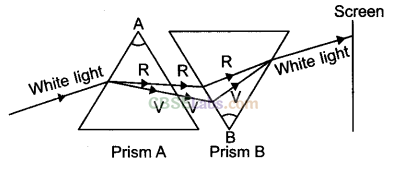 >
>
Question 5. Is the position of a star as seen by us its true position? Justify your answer.
Answer. Light from stars passing through the atmosphere, bends due to changing refractive index of different layers of the atmosphere and appears as if it comes from a higher level than they are actually. So, the stars appear slightly higher than the actual position.
Long Answer Questions
Question 6. Explain the structure and functioning of Human eye. How are we able to see nearby as well as distant objects?
Answer. Human Eye: The natural optical device through which one could see objects around him. It forms an inverted and real image on a light sensitive surface called the retina.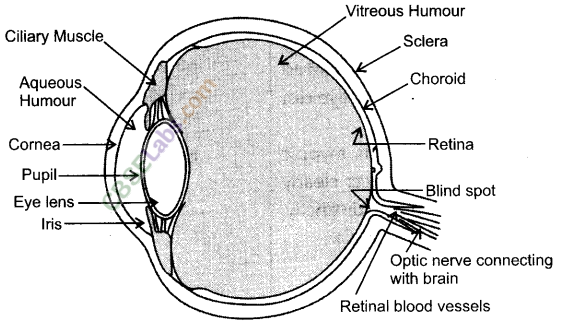
Parts of human eye are:
- Iris: It is a dark muscular diaphragm that controls the size of the pupil.
- Pupil: The black opening between the aqueous humour and the lens. Since, light does not get reflected from it, so its appearance is dark. The amount of light entering the eye is controlled by the size of the pupil. In dim light, it opens up completely through the iris, but in bright light, it becomes very small. •
- Cornea and Aqueous Humour: Acting as lens, they provide the refraction for light rays entering the eye. Cornea is a thin membrane covering the surface of eyeball, through which light enters. Aqueous humour is a transparent gelatinous fluid filled between cornea and eye-lens.
- Ciliary Muscles: These muscles hold the eye lens in vertical position and change the focal length of eye lens to form the sharp image of objects located at different distances on the retina.
- Retina: The light sensitive surface of eye on which image is formed. It is equivalent of the photographic film in a camera. It contains rods and cones.
- Rods and Cones: The cells in retina, which are light and colour sensitive. Rods respond to the intensity of light. Cones respond to the colour. There are around 125 million rods and cones. The cells generate signals which are transmitted to the brain through optical nerves. The brain process the information via these electric signals and give the impression of erect image to us.
To see nearby as well as distant objects, ciliary muscles modify the curvature of eye lens. This leads to variation in focal length. When the muscles are relaxed, the focal length of the lens has its maximum value, equal to the distance from the retina. So, parallel rays coming into the eye get focussed on the retina. When the eye looks at nearby objects, the ciliary muscles are strained and the focal length decreases. So, that sharp image again forms on the retina.
Question 7. When do we consider a person to be myopic or hypermetropic? Explain using diagrams how the defects associated with myopic and hypermetropic eye can be corrected?
Answer. A person can be considered as myopic when he can see nearby objects clearly but cannot see distant objects distinctly. This defect of eye is called myopia.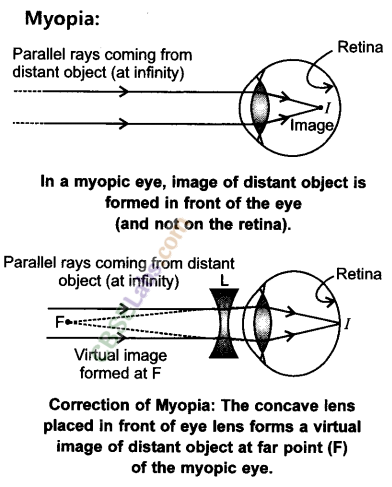
When the person cannot see nearby objects clearly but able to see distant objects clearly, the person can be treated as hypermetropic. The eye defect is called hypermetropia.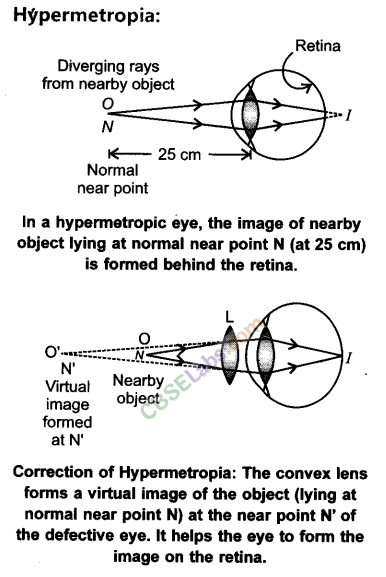
Extra Questions – Human Eye and Colourful World – CBSE Class 10 Science
According to new CBSE Exam Pattern, MCQ Questions for Class 10 Science pdf Carries 20 Marks.
Question-1
Why is eye lens of telescope smaller than objective lens?
Solution:
The eye lens of telescope is smaller than its objective lens to sharpen the image which is obtained using telescope.
Question-2
What is short sight? How can it be corrected?
Solution:
If a person can see nearer objects clearly but not the far objects, then he is affected by short sight. It can be corrected using a suitable concave lens.
Question-3
Give the condition required to achieve a larger magnification of a small object by a compound microscope ?
Solution:
To achieve a larger magnification of a small object, both the objective and the eyepiece of a compound microscope should have smaller focal lengths. Magnification of the order of 1000 is possible with very good design of the microscopes, such as in the oil-immersion type of microscopes.
Question-4
A person having a myopic eye used the concave lens of focal length 50cm. What is the power of the lens?
Solution:
The formula for the power of lens is Power (P) = 1/f.
P = 1/50 = 0.02 dioptre.
Question-5
Which part of human eye helps in the perception of colours?
Solution:
The retina of the human eye has a large number of cone-shaped and rod-shaped cells. The rods respond to the intensity of light and the cones to the colours. These help us to perceive colours.
Question-6
Define the term “accommodation of the eye”.
Solution:
The ability of the eye to focus on near and distant objects, by adjusting its focal length, is called the accommodation of the eye.
Question-7
Define “least distance of distinct vision”.
Solution:
The smallest distance, at which the eye can see objects clearly without strain, is called the near point or the least distance of distinct vision. For a young adult with normal vision, it is about 25cm.
Question-8
Differentiate between a microscope and a telescope based on its use.
Solution:
A microscope is an optical instrument which is used to see the finer details of tiny objects, and a telescope is used for viewing distant objects clearly.
Question-9
How is the length of the telescope tube related to the distance between the objective and the eyepiece of the telescope? How can the magnification of the telescope be increased?
Solution:
The length of the telescope tube is equal to the distance between the objective and eyepiece of the telescope. In order to increase the magnification of the telescope, the objective must have a large focal length and the eyepiece a small focal length.
Question-10
Why does the objective lens of an astronomical telescope have a large light gathering power?
Solution:
The objective lens of a telescope has a large aperture to have a large light gathering power.
Question-11
Explain clearly the working of a human eye?
Solution:
The light rays coming from the object kept in front of us enter the pupil of the eye and fall on the eye-lens. The eye-lens is a convex lens, so it converges the light rays and produces a real and inverted image of the object on the retina. The image formed on the retina is conveyed to the brain by the optic nerve and gives rise to the sensation of vision. The light-sensitive cells present in the retina gets activated and generates electrical signals. The retina sends these electrical signals to the brain through the optic nerve and gives rise to the sensation of vision. The mind interprets the inverted image formed on the retina as an erect object.
Question-12
How does the eye adjust itself to deal with light of varying intensity?
Solution:
The amount of light entering the eye is controlled by the pupil. If the intensity of the outside light is low, then the pupil expands to allow more light to enter the eye. If the outside intensity is high, then the pupil contracts so that less light enters the eye.
Question-13
Which phenomenon of vision is made use of in cinematography? Explain briefly how it is used.
Solution:
Persistence of vision is made use of in cinematography. It is the ability of an eye to continue to see the image of an object for a very short duration even after the removal of the object. We are able to see the movie pictures in a cinema due to the persistence of vision.
The still pictures taken by a movie camera are projected on the screen at a rate of about 24 pictures per second. Under these conditions, the image of one picture persists on the retina till the image of next picture falls on the screen and so on.
Due to this, the slightly different images of the successive pictures present on the film merge smoothly into one another and give us the feeling of moving images. Thus the principle of persistence of vision is made use of, in the motion picture projection in cinematography.
Question-14
How do we see colours?
Solution:
The retina of our eyes has a large number of light sensitive cells. The cells on the retina are of two shapes:
(i) Rod shaped and
(ii) Cone shaped
The rod shaped cells of our retina respond to the intensity of light. The cone shaped cells of our retina respond to colours. These cells make us see colours and to distinguish between them. Thus cones make colour perception possible.
Question-15
How does an eye focus the objects lying at various distances?
Solution:
An eye can focus the images of the distant objects as well as that of the nearby objects on its retina by changing the focal length of its lens. The focal length of the eye-lens is changed by the action of the ciliary muscles. The ciliary muscles can change the thickness of the eye-lens and hence its focal length changes the converging power of the eye-lens.
Question-16
When is a person said to have developed cataract in his eye? How is the vision of a person having cataract restored?
Solution:
Cataract develops when the eye-lens of a person becomes unclear due to the formation of a membrane over it. The vision of a person having cataract can be restored after getting cataract surgery done on the eye-lens having cataract. This defect cannot be corrected by any type of spectacle lenses.
Question-17
Where should an object be placed in front of a convex lens so as to use it as a simple microscope?
Solution:
The object should be placed within the focus of the convex lens to use it as a simple microscope.
Question-18
If we need magnification of 375 from a microscope of tube length 15 cm and objective of focal length 0.5 cm, what focal length of eye-piece should we use?
Solution:
Magnification m = 375
Length of the tube L = 15 cm
Focal length of the objective fo = 0.5 cm
We know that
Question-19
If focal length of the objective and eye-piece of a telescope are 10 cm and 4 cm respectively, what will be its magnifying power in
(i) normal adjustments,
(ii) adjustment where image of distance object is formed at D? Given D = 25 cm.
Solution:
Focal length of objective fo = 10 cm
Focal length of eyepiece fe = 4 cm
(i) In normal adjustment
Question-20
Which of the two, objective or eye-piece, of a telescope has a large aperture? Give reason for your answer.
Solution:
The objective lens of a telescope has a large aperture, because it can gather more light from the distant object and form a bright image of the distant object.
Question-21
What are the common defects of vision that can be corrected by the use of suitable eyeglasses or spectacles?
Solution:
There are mainly four common defects of vision that can be corrected by the use of suitable eye glasses or spectacles. These are
(i) Myopia or near-sightedness,
(ii) Hypermetropia or far-sightedness,
(iii) Presbyopia, and
(iv) Astigmatism.
Question-22
What property of the eye is the principle of motion, pictures?
Solution:
Refraction of light through the eye lens is the basic principle for the visualization of pictures and motion.
Question-23
What are coaxial lenses and where are they used?
Solution:
Coaxial lenses are lenses having common principal axes. A compound microscope, in its simple form, consists of coaxial lens (two lenses having common principal axes) mounted on the outer ends of two hollow metallic tubes. One of the two lenses acts as the objective and the other as the eyepiece.
Question-24
Draw a diagram of a simple microscope.
Solution:
Question-25
How does the eye adjust its focal length?
Solution:
The eye adjust its focal length by means of its ciliary’s muscles.
Question-26
Explain presbyopia and astigmatism.
Solution:
Presbyopia is part of the natural aging process of the eye, and can be easily corrected. Technically, presbyopia is the loss of the eye’s ability to change its focus to see objects that are near. It is not a disease. It’s as natural as wrinkles, and it affects everybody at some point in life. Presbyopia generally starts to appear around age 40.
Astimagtism: The cornea is the transparent layer over the colored part of the eye. It bends (refracts) light rays and helps focus the light onto the retina in the back of the eye so people can see. When the cornea is oblong shaped, it causes light rays to focus on two different points on the retina, instead of just one. As a result, people with significant astigmatism may have distorted or blurry vision.
Question-27
A person uses convex lens spectacles. What vision defect does he have? Draw a diagram
(i) to show the defective eye
(ii) to show the correction with the lens.
Solution:
When a person uses convex lens to cure his long sight (hypermetropia).
Long Sight
Question-28
How is the terrestrial telescope different from the astronomical telescope?
Solution:
The terrestrial telescopes have one more additional convex lens (erecting lens), placed between the objective and the eyepiece, to make the final image erect. This erecting lens is not required in the astronomical telescope as the celestial objects that are viewed using a astronomical telescope are spherical in shape, so it does not matter whether the final image is inverted or erect.
Question-29
How will you distinguish between a compound microscope and a telescope.
Solution:
A compound microscope uses a very short focal length objective lens to form a greatly enlarged image. This image is then viewed with a short focal length eyepiece used as a simple magnifier. The image should be formed at infinity to minimize eyestrain.
A telescope is an instrument designed for the observation of remote objects. The term usually refers to optical telescopes, but there are telescopes for most of the spectrum of electromagnetic radiation and for other signal types.
Question-30
A lens used as a simple magnifier gives magnification of 6. What is its focal length?
Solution:
Question-31
A compound microscope has an objective of focal length 1.0 cm and an eyepiece of focal length 4.0 cm. If the length of the tube is 20 cm, find the magnification of the compound microscope.
Solution:
Question-32
A telescope has an objective of focal length 140.0 cm and an eyepiece of focal length 5.0 cm. Find
(i) the magnification of the telescope for viewing distant objects for normal adjustment
(ii) separation between the objective lens and the eyepiece.
Solution:
Objective of focal length, f0 = 140.0 cm.
Eyepiece if focal length, fe = 5.0 cm.
Question-33
A 52-year old near-sighted person wears eye-glass with a power of –5.5 dioptres for distance viewing. His doctor prescribes a correction of +1.5 dioptres in the near-vision section of his bi-focals. This is measured relative to the main part of the lens (i) What is the focal length of his distance-viewing part of the lens? (ii) What is the focal length of the near-vision section of the lens?
Solution:
Question-34
What is Astigmatism?
Solution:
Astigmatism is the defect of an eye due to which a person cannot focus on both the horizontal and vertical lines, simultaneously. The reason for this defect is irregularities on the surface of the cornea.
Question-35
Explain the angle of prism.
Solution:
A triangular glass prism consists of three rectangular lateral surfaces and two triangular bases. Lateral faces are inclined to each other and the angle between two lateral surfaces is called the angle of prism.
Question-36
What is dispersion?
Solution:
The splitting of white light into its seven colours on passing through a transparent medium (e.g. glass prism) is called dispersion of light.
Question-37
What is spectrum?
Solution:
When a white light is passed through a transparent medium, the white light splits into seven colours which are made to fall on a white screen. This coloured band is called spectrum.
Question-38
Why is the colour of the clear sky blue?
Solution:
The scattering of sunlight due to the air molecules in the atmosphere causes the sky to appear blue. Shorter wavelength (Blue colour) is scattered more compared to longer wavelength (Red colour). The scattered blue light enters our eyes.
Question-39
What is phorias?
Solution:
This is a defect of eye. With this defect, the eye sees two images of one object. This defect is due to lack of balance among the muscles which hold the two eyes in their axes. This lack of balance produces cross-eyes. It is remedied by using Prismatic lenses.
Question-40
Write the names of colours got from the word VIBGYOR.
Solution:
V – Violet
I – Indigo
B – Blue
G – Green
Y – Yellow
O – Orange
R – Red.
Question-41
Why is the colour of the clear sky blue?
Solution:
The scattering of sunlight due to the air molecules in the atmosphere causes the sky to appear blue. Shorter wavelength (Blue colour) is scattered more compared to longer wavelength (Red colour). The scattered blue light enters our eyes.
Question-42
What is optic axis?
Solution:
The straight line passing through the centre of the cornea and the lens is called optic axis of the eye.
Question-43
What is visual axis?
Solution:
The line passing through centre of the lens and fovea centralize is called visual axis of the eye. When an object is to be seen more minutely, it is brought on the visual axis to get its image on yellow spot which is the most sensitive part of the retina.
NCERT Solutions for Class 10 Science All Subject NCERT Solutions
- Chapter 1 Chemical Reactions and Equations
- Chapter 2 Acids, Bases and Salts
- Chapter 3 Metals and Non-metals
- Chapter 4 Carbon and Its Compounds
- Chapter 5 Periodic Classification of Elements
- Chapter 6 Life Processes
- Chapter 7 Control and Coordination
- Chapter 8 How do Organisms Reproduce?
- Chapter 9 Heredity and Evolution
- Chapter 10 Light Reflection and Refraction
- Chapter 11 Human Eye and Colourful World
- Chapter 12 Electricity
- Chapter 13 Magnetic Effects of Electric Current
- Chapter 14 Sources of Energy
- Chapter 15 Our Environment
- Chapter 16 Management of Natural Resources
.png)
.png)